

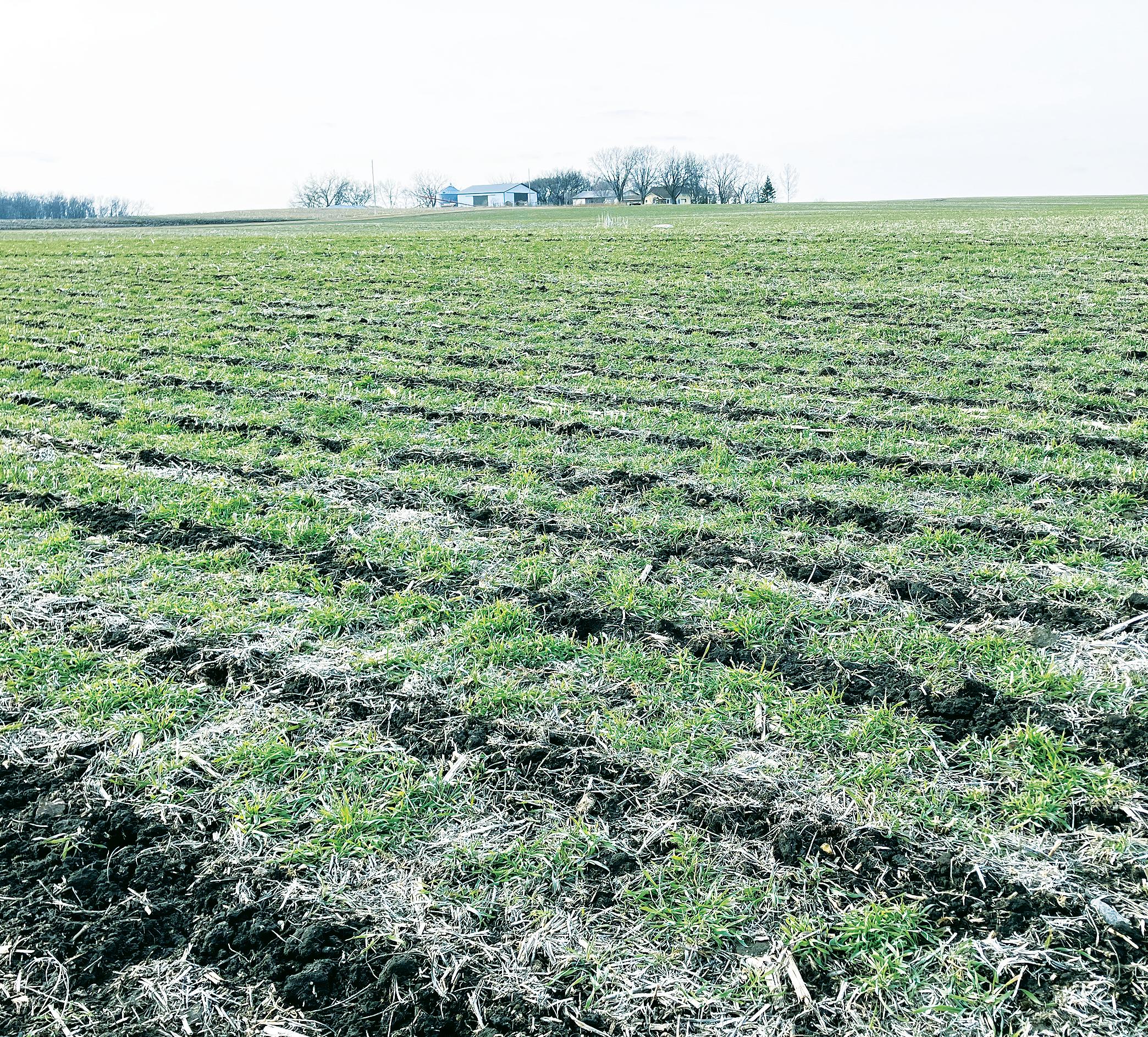
1976, Where Farm and Family Meet” 418 South Second St., Mankato, MN 56001 • (800) 657-4665 www.TheLandOnline.com • theland@TheLandOnline.com April 12, 2024 © 2024
Gold in the green? For
Discover Beck's
Did You Know?
“Since
INSIDE THIS ISSUE: Vilsack stumps in Minnesota; Selecting show pigs requires biosecurity too; Richard Siemers takes us to Milan ... and more!
every 1,000-plant increase in corn populations, root size declines by 2.5%*.
Root Reveal™ Research now.
Cover crops can mean extra cash if you have the data to back it up.




Deb Petterson: dpetterson@TheLandOnline.com
Office/Advertising Assistants:
Joan Compart: theland@TheLandOnline.com
Lyuda Shevtsov: auctions@thelandonline.com
For Customer Service Concerns: (507) 345-4523, (800) 657-4665,
Because of the nature of articles appearing in The Land, product or business names may be included to provide clarity. This does not constitute an endorsement of any product or business. Opinions and viewpoints expressed in editorials or by news sources are not necessarily those of the management. The Publisher shall not be liable for slight changes or typographical errors that do not lessen the value of an advertisement. The Publisher’s liability for other errors or omissions in connection with an advertisement is strictly limited to publication of the advertisement in any subsequent issue or the refund of any monies paid for the advertisement.
Classified Advertising: $21.99 for seven (7)
Spring cleaning
It’s been a busy month here at The Land. Many organizations look to grab farmers’ attention before spring field work starts and March was no exception. Cleaning out my handy reporter’s notebook, here are a few events you might have missed.
On March 19, GreenSeam released the results of its annual “State of Agriculture” report. GreenSeam is an economic development organization for food and agriculture in southern Minnesota and northern Iowa, and it is part of Greater Mankato Growth. This is the fifth year GreenSeam has surveyed agriculture producers, businesses and educators on a variety of topics ranging from workforce availability, training, government regulations and challenges within the industry.

structure. “We have to attract people to move in to a community,” Spencer said. “This means housing for employees and the availability of child care. It’s a human capital issue.”
An interesting sideline GreenSeam had to deal with in this year’s survey was the number of computer-generated responses. Dr. Megan Roberts is an assistant professor of management at MSUM, and the agribusiness and food innovation program director at the College of Business. She spearheaded the research team for the GreenSeam survey. “We actually had 530 responses to the survey,” she said, “but a number of those came from robots and artificial intelligence. A lot of scammers took the survey.”

Three hundred and thirty-four responders took part in the survey, led by the crop and livestock industry (35.7 percent) and professional services (12.9 percent). The vast majority were owners or managers of their organization.
GreenSeam President and Director Sam Ziegler referred to results of the recent NASS “Census of Agriculture” report and the lack of Congress’ progress on drafting a new Farm Bill. “There is a ripple effect of 2 million fewer ag acres in the United States,” Ziegler said. “Weather remained a significant concern, impacting crop yields for farmers. The high cost of production and low pork and dairy prices have also had a significant impact on farmers and communities.”
“On the other hand,” Ziegler went on to say, “the economy exceeded expectations. Increased spending, strong talent recruitment and crop resilience made what could have been a catastrophic growing season turn out better than expected.”
Recruiting a capable, reliable work force continues to be a challenge for all agriculture-related businesses. DQ Spencer, a professor of business management at Minnesota State University Mankato, says more businesses (54 percent in the survey) have turned to internships as a way to aid students down their career path, and 52 percent providing parttime jobs.
“Find the talent, retain the talent,” Spencer said. “In 2023 a lot of the issue was ‘Where are the people?’ Now it’s more of ‘how do I manage the people and how do I retain the people?’”
Spencer added there is a lack of awareness of job opportunities in the agriculture field. While MSUM is embarking on creating an Agriculture and Agribusiness undergraduate program, Spencer feels students at a much younger age need to be exposed to the diversity of ag-related options.
The other major stumbling block in bringing young people into the ag industry is rural infra-
Roberts said 76 percent of respondents feel that Minnesota agriculture is headed in the right direction, which is down from 82 percent in the 2023 survey. Responders in the 2020 survey also posted a 76 percent optimism. That number jumped to 92 percent in 2021, but dropped back down to 83 percent in 2022.
In addition to rising costs, Roberts points out that the lower optimism from last year could be pinned on lower commodity prices. “I thought, ‘Let’s do a year-over-year look at cash corn and cash soybean prices,’” she said. “So 365 days ago, we were — give or take depending where your basis is and where you’re hauling it to — we saw $2.20 more per bushel for cash corn, and approximately $3 per bushel more for cash soybeans. That’s a pretty significant reduction in cash grain prices.”
Complete results of the GreenSeam “State of Agriculture Report” can be found online at greenseam.org.
On March 28, Jodi DeJong-Hughes, a Regional Educator with the University of Minnesota Extension, led a discussion comparing conventional tillage to alternative tillage practices at a workshop in Arlington, Minn.
A healthy crowd attended to learn the effects of conventional tillage practices on soil health and how even modest modifications involving no-till, strip-till or vertical till can quickly improve organic matter in soil.
Reduced or conservation tillage leaves at least 30 percent of the residue on the soil surface following planting of the next cash crop. One of the main benefits of conservation tillage includes protecting valuable topsoil from erosion by leaving residue on the surface and improving soil aggregate stability.
“Even a one percent increase in organic matter adds additional days of available water to crops,” DeJong-Hughes explained. “And in years involving drought, that can make a big difference in yields.”
PAGE 2 www.thelandonline.com — “Where Farm and Family Meet” THE LAND — APRIL 12, 2024 LAND MINDS By Paul Malchow
See LAND MINDS, pg. 8
St.
Vol. XLVIII ❖ No. 8 24 pages, 1 section plus supplements Cover photo by Paul Malchow COLUMNS Opinion 2-4 Farm and Food File 4 Kitchen Classics 6 Deep Roots 5 Green & Growing 7 Calendar of Events 9 Swine & U 10 Mielke Market Weekly 14 Marketing 15 Auctions/Classifieds 18-23 Advertiser Listing 23 Back Roads 24
Publisher: Steve Jameson: sjameson@mankatofreepress.com General Manager: Deb Petterson: dpetterson@TheLandOnline.com Managing Editor: Paul Malchow: editor@TheLandOnline.com Staff Writer: Laura Cole: lcole@TheLandOnline.com Staff Writer Emeritus: Dick Hagen: rdhagen35@gmail.com Advertising Representatives:
OPINION
www.TheLandOnline.com facebook.com/TheLandOnline twitter.com/TheLandOnline 418 South Second
Mankato, MN 56001 (800) 657-4665
STAFF
Dan McCargar: (507) 344-6379, dmccargar@thelandonline.com
Fax:
theland@TheLandOnline.com
(507) 345-1027 For Editorial Concerns or Story Ideas: (507) 344-6342, (800) 657-4665, editor@TheLandOnline.com
private classified,
additional line
$1.40; $26.89 for business classifieds, each additional line
$1.40. Classified ads accepted by
or by phone with VISA, MasterCard, Discover or American Express. Classified ads can also be sent
Mankato,
include
on
Classified
may
called into (800) 657-4665. Deadline for classified ads is 5 pm on the Friday prior to publication date, with holiday exceptions. Distributed to farmers in all Minnesota counties and northern Iowa, as well as on The Land’s website. Each classified ad is separately copyrighted by The Land. Reproduction without permission is strictly prohibited. Subscription and Distribution: Free to farmers and agribusinesses in Minnesota and northern Iowa. $59 per year for non-farmers and people outside the service area. The Land (USPS 392470) Copyright © 2024 by The Free Press Media is published biweekly by The Free Press, 418 S 2nd Street, Mankato, MN 56001-3727. Business and Editorial Offices: 418 S. 2nd Street, Mankato, MN 56001-3727, Accounting and Circulation Offices: Steve Jameson, 418 S 2nd Street, Mankato, MN 56001-3727. Call (507) 345-4523 to subscribe. Periodicals postage paid at Mankato, MN. Postmaster and Change of Address: Send address changes to The Land, 418 South Second St., Mankato MN 56001-3727 or e-mail to theland@ TheLandOnline.com.
lines for a
each
is
is
mail
by e-mail to theland@TheLandOnline.com. Mail classified ads to The Land, 418 South Second St.,
MN 56001. Please
credit card number, expiration date and your postal address with ads sent
either mail version.
ads
also be
Letter: Take another look at environmental claims
To the Editor,
Here are some things to consider in regard to a recent opinion letter “Farmers always concerned about the environment” (The Land, March 29).
OPINION
I have not been able to find a science generated prediction indicating New York (city, I presume) and Miami would be under water by the year 2024. The National Oceanic Atmospheric Administration did say there was no appreciable difference in the number of storms in the past 100 years. However, the NOAA analysis concluded future hurricanes will be more intense with higher rainfall rates as a result of global warming. NOAA went on to say rising sea levels, another effect of climate change, will increase the threat of flooding.
According to NASA, the temporary thickening of Greenland’s biggest glacier is due to a cyclical shift in ocean currents called North Atlantic Oscillation. Of course, cyclical means changing, for now it is cold
but it will change back to warm. Here’s an important point, NASA estimates from 1985 to 2022 the Greenland ice sheet has lost 1,140 billion tons of ice, and worldwide, for the 33rd consecutive year, glaciers have receded according to the World Glacier Monitoring Service.
In Australia a man named Jon Edwards combined a generator with an EV charging station to see if it was a feasible option in areas not supported by an electric grid or in an emergency situation.
Diesel powered EV charging stations would not be a typical or everyday application, but they can play a niche role in emergency, temporary or extreme circumstances; according to Jeremy Michalek of Carnegie Mellon.
“Clear cutting can cause rapid regeneration of shrubs and trees that can create highly flammable fuel conditions within a few years”; U.S. Forest Service, Department of Interior.
Letter: Where do rights and freedoms end?
To the Editor, Mr. Thiesse and I have a lot in common. We both place a high value on freedom.
OPINION
harder for those people to abuse that freedom? Deciding how to keep the majority free by limiting some freedoms for others is not “socialism,” but rather just common sense.
“A dense forest that has a lot of trees and a lot of bio mass also has a higher canopy cover.
The trees above and dead and downed logs soak up and retain huge amounts of moisture and soil moisture”; Chad Hanson PH.D. Ecologist.
I don’t know if EV’s are the solution to transportation problems but I do find it difficult to believe it’s a good thing for world energy to be dependent on Venezuela, Russia, and Saudi Arabia. I might well be alarmist, elitist, and socialist, but I don’t think our policies should be based on half-truths and innuendos while at the same time playing the victim.
Richard Nixon with help from Henry Kissinger and H.R. Haldeman were exercising their freedoms when they sabotaged Vietnam peace talks for their own political advantage. At least partially because of them, the killing and suffering went on for years. Be careful with your freedoms.
Chuck Von Ruden (Address withheld by request)
However, there is no freedom that is absolute. Many times, we must give up some freedom to protect or acquire other freedoms, including those (use of electric cars and global warming) which are mentioned in his letter in the March 29 edition of The Land (“Farmers always concerned about the environment”).
As an example, we have the freedom of speech, but should that allow us speech that endangers others? Should the freedom of speech include the right to tell lies like some of our news media or some of our politicians and their supporters? Do those lies make it harder for us as a group to determine what is right and what is wrong? We do need to place some limits on our freedom of speech to protect the freedom for all of us. Limits or rules — like having stop signs at intersections — make all drivers freer to move about more safely. Yet some would like to remove all stop signs.
We have the right to own and keep a gun to protect ourselves, but should that right extend to being able to use that gun on others for mass killing? Are there some simple and effective ways of making it
In these disagreements that develop regarding freedom, we need to ask ourselves a question. Who are we supporting? Are we supporting those who are abusing the freedom so that there is a need for limits to be placed on all of us; or are we supporting all of us who are in danger of losing more freedoms and possibly our lives? I want to protect as much freedom as possible for all of us; not support or protect those who are working to misuse freedom to benefit themselves at the expense of the rest of us.
As our population grows, there are simply more people that affect our individual freedoms and that alone requires more rules. I am not sure Mr. Thiesse is correct (or it could be sarcasm), that those living in the more populated east coast have any more answers than those of us who are fortunate enough to live in less populated parts of our country. I do know that my present freedoms here in the United States are greater than they are in most other parts of the world. For that I am eternally grateful.
Doug Kolbe Owatonna, Minn.

COLORS 26-29
for half the price
COLORS 26-29 GAUGE Residential and round roof applications
COLORS 26 GAUGE Commercial and Perlin applications
COLORS 26-29 GAUGE
durability THE LAND — APRIL 12, 2024 www.thelandonline.com — “Where Farm and Family Meet” PAGE 3
30
GAUGE Standing seam architecture look
30
30
30
Standard all around
Letters to the editor are always welcome. Send your letters to: Editor, The Land, 418 South Second St., Mankato, MN 56001 e-mail: editor@thelandonline.com All letters must be signed and accompanied by a phone number (not for publication) to verify authenticity.
$1 billion to refinance status quo won’t stop ag pandemics
When word came out of Texas on April 1 that avian flu had made another unwelcome hop — this one from a dairy cow to a human — the news seemed like an April Fool’s joke.
It wasn’t. In fact, highly pathogenic avian influenza (HPAI or bird flu), the quick-killing disease which has led to either the death or slaughter of 82 million chickens, turkeys and other birds in the U.S. since 2022, had jumped not one, but two species in just two weeks.
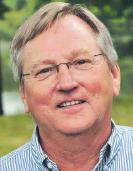
FARM & FOOD FILE
By Alan Guebert
The first reported instance of species jump came in mid-March after a handful of newly-born goats died on a Minnesota farm that had had a bird flu outbreak in its poultry flock, according to state health officials. (Minnesota is the nation’s largest turkey-growing state, raising between 42 and 45 million birds per year.)
OPINION
“Since bird flu outbreaks began almost two years ago,” our friends at the Food and Environmental Reporting Network (FERN) noted Jan. 9, “the USDA [U.S. Department of Agriculture] has spent more than $1 billion to compensate farmers for lost flocks and to suppress the spread of the viral disease.”
Compensation, yes; suppression, well, good luck with that.
In fact, this is the second USDA “compensation and suppression effort” on avian flu in just the last decade. The “2014-2015 outbreak,” as USDA’s Animal and Plant Health Inspection Service (APHIS) explained, cost taxpayers “nearly $850 million… for response activities… and indemnity payments.”
ness” doesn’t include changes to today’s industrial poultry and livestock production systems that often stack, stuff, and stash as many birds, hogs, and cattle into disease-fostering confinement systems that can — and do — become breeding grounds for chronic ailments affecting both animals and humans.
And confinement means confinement. For example, USDA’s 2022 Ag Census shows that 75 percent of all U.S. egg production comes from 347 “facilities” that house, on average, 850,000 birds.
Likewise, reports the census, 834 dairy operations with an average of 8,300 cows apiece, account for 42 percent of the national dairy herd.
Two weeks later, HPAI was detected in dairy cattle in five disparate states: Texas, New Mexico, Michigan, Idaho and Kansas.
State and federal agriculture and food safety officials raced to assure the public that America’s dairy supply was not threatened because avian flu is not life threatening to ruminants like it is in birds.
Then, the week before Easter, a dairy worker in Texas (who the Texas Department of State Health Services described to the Washington Post as someone who “worked directly with sick cows at the dairy,”) tested positive for the virus. His only symptom, however, was a treatable “eye inflammation.”
But, the Post added, “The newly emerged case does not change the risk of the general public, which remains low, federal officials said.”
America’s poultry flocks — mostly egg-laying chickens, broiler (meat) chickens, and turkeys — remain highly vulnerable to the current strain of avian flu. Since its latest outbreak in February 2022, more than 80 million poultry (mostly egg-laying chickens) in 47 states have been killed by disease.
The high number is attributed to the protocol tied to HPAI’s discovery in any flock: total depopulation in an attempt to limit its spread. It’s both a costly and, to date, completely ineffective cure.

And, added APHIS, after spending “another $100 million… for further preparedness… it was the most expensive animal health incident recorded in U.S. history.”
Until this one anyway, 10 years and at least another $1 billion later.
That’s mostly because USDA’s “further prepared-
Why would this precariously balanced, pandemicfostering system ever change if taxpayer money (according to FERN, $715 million of USDA’s $1 billion has been spent on “indemnities… to producers, growers, and integrators for depopulated birds and eggs”) refinances the entire tottering enterprise every 10 years or so?
The Farm and Food File is published weekly through the United States and Canada. Past columns, events and contact information are posted at www.farmandfoodfile.com. v
Letter: ‘Elitist hate’ is a ‘despicable lie’
To the Editor,
OPINION
I’m concerned by the vast amount of misinformation and lies that have been spreading in America and championed by Donald Trump with his 30,000+ lies and misstatements when he was in office and now continuing unabated ever since.
Michael Thiesse’s recent letter (“Farmers always concerned about the environment,” The Land, March 29) is a prime example of someone spun up in unreality. He fails to understand that NOAA scientists are concerned with storm intensity, not with the number of storms. NASA is not reporting that Greenland glaciers are growing. This year NASA reported that 179 Greenland glaciers have shrunk and only one has increased in size slightly.
Our nation’s plan is not to charge lithium batteries with diesel engines. Lithium batteries are not an “environmental catastrophe” when they die. They are infinitely recyclable!
Clear-cutting forests is acceptable in some situations if severe erosion is unlikely, for example, but we will not clear-cut the entire West to avoid wildfires.
Saying that “elitists just hate everything about rural America” is a despicable lie. I am a retired farmer also, but I understand the extreme importance of knowledge and truth. We can shut our eyes to reality or we can work together for solutions.
Greg Rendahl Ostrander, Minn.
NASS discontinues select data reports
The U.S. Department of Agriculture’s National Agricultural Statistics Service is canceling the July Cattle report and discontinuing all county estimates for crops and livestock beginning with the 2024 production year. USDA says the decision to discontinue these surveys and reports was not made lightly, but was necessary, given appropriated budget levels.
NASS has and will continue to review its estimat-
ing programs using criteria focused on the needs of its mission and customers to prioritize budget decisions.
Information about all NASS surveys and reports is available online at www.nass.usda.gov.
This article was submitted by the U.S. Department of Agriculture.
Southwest Sales Region Rochester PAGE 4 www.thelandonline.com — “Where Farm and Family Meet” THE LAND — APRIL 12, 2024 www.TheLandOnline.com
v
The treasures of heaven should include books
Spring break for my children felt less like spring this year. In fact, it began with a blizzard (and not the Dairy Queen kind) which left us with a blanket of wet, heavy snow and icy driving conditions. In fact, the less-than-ideal road conditions caused us to cancel our day trip to Walnut Grove, where we planned to visit the Laura Ingalls Wilder Museum.

DEEP ROOTS
By Whitney Nesse
In the following days, the wind picked up, which was not ideal for playing outside. I began feeling more than a little cooped up with a house full of my own children — plus extras!
One of the perks of living in a small, rural community is accessibility. With one phone call, I discovered that the
gym was not in use during the day, and my family could use it before the evening pickleballers showed up. To my advantage, the gym and the public library are in the same building, and the hours I planned to take my crew to the gym coincided with the library hours.
I have always admired and almost envied our local librarian. She is always cheery, knows about the best books, and works in a warm, cozy, quiet area! Who wouldn’t love that? I told her that it appeared she had the dream job with endless books she could sit and read all day! She chuckled at me and asked, “When was the last time you saw me sitting and reading while
I was here?”
Touche. The answer was, “Never!”
While I am at the library, she is usually fielding rapid-fire questions from my children about books, hobbies, interests, and if there are any new graphic novels to check out.
I confess I have romanticized the idea of being a librarian. It is far removed from sitting with the latest novel in an overstuffed chair, covered with a warm blanket and a fresh, never-ending, steaming cup of coffee.
As the librarian helped my children find books to fit their reading level and interests, I mused at the thought of someday getting lost in a gigantic library surrounded by books. Then I realized my musing may someday be a reality. One of my favorite Bible verses comes from the Gospel of John in
chapter 21, verse 25, “Now there are also many other things that Jesus did. Were every one of them to be written, I suppose that the world itself could not contain the books that would be written” (ESV).
I imagine heaven might have a library that does contain books with all the things Jesus did in them. Maybe there, I can cozy up, reading the testimonies of my Savior forever. For now, I will enjoy the quiet of my home while my kids are busy reading, and I will settle in with my favorite book, leather-bound, worn, marked-up, and tattered, the most remarkable story ever told.
Whitney Nesse is a sixth-generation livestock farmer who is deeply rooted in her faith and family. She writes from her central Minnesota farm. v
Minnesotans must apply for hemp licenses by April 30
ST. PAUL — Those wanting to grow and process hemp in Minnesota in 2024 must apply for a license with the Minnesota Department of Agriculture by April 30. A license from the MDA is required for individuals and businesses and is valid for the 2024 calendar year.
The application can be found on the MDA website at www.mda.state. mn.us/. Along with the online form, first-time applicants and authorized representatives need to submit fingerprints and pass a criminal background check.
Every lot of hemp grown requires
pre-harvest THC regulatory testing. Each official regulatory sample collected by the MDA will cost $100.
The MDA licenses processors that handle raw hemp and initially process it by extraction, decortication, devitalization, crushing or packaging. The department will continue random inspections of processor locations.
The minimum cost of a grower license is $400. A processing license is a minimum of $500. These licenses are for growing and processing industrial hemp only. The hemp grower or processor application is not for the growth or
Soil health grant requests high
ST. PAUL — Demand is high for the Minnesota Department of Agriculture’s Soil Health Financial Assistance Grant.
The MDA recently awarded 81 grants to purchase or retrofit soil health equipment. The grants total over $2.35 million.
Interest far outpaced available funding. The MDA received 284 applications for $8.4 million in requests — more than three times the money in this round of grants.
The grants will provide up to 50 percent cost-share for equipment and parts, up to a cap of $50,000.
“Given the amount of interest in this program, we see Minnesota farmers want to invest in healthy soils that provide important benefits to water quality and our other natural resources,” said MDA Commissioner Thom Petersen. “Specialized equipment and machinery can be a financial barrier for most producers trying to implement soil health practices.”
Applications for the next round of the Soil Health Financial Assistance Grant will open in August.
This article was submitted by the Minnesota Department of Agriculture.v
sale of adult-use or medical cannabis. The application is also not intended for the sale of hemp-derived cannabinoid products.
Adult-use cannabis information can be found on the Office of Cannabis Management website (https://cannabis. state.mn.us/).
Information related to medical can-
nabis and hemp-derived cannabinoid products can be found at the Minnesota Department of Health website (https:// www.health.state.mn.us/).
Questions about the MDA’s Industrial Hemp Program should be sent to hemp. mda@state.mn.us or (651) 201-6600.
This article was submitted by the Minnesota Department of Agriculture.v








Apri1 18-20 Thursday&Friday8:00am -8:00pm Saturday9:00am -4:00pm Checkout the latest models! Flagstaff E-Pro Cedar Creek Catalina NuCamp Little Guy TheBlackHole Nor thWind Fish House Join us forour 2024 Open House! Pulled pork sandwiches from 4-6Thurs &Fri and 11-2 on Saturday 15% off all storemerchandise! Keepers RV Since ‘63 Fantastic Pricing On Our Holdover Models! (507) 625-4647 Holdover Located of f Hwy 22, South of Mankato 625 4647 www keepersr v com THE LAND — APRIL 12, 2024 www.thelandonline.com — “Where Farm and Family Meet” PAGE 5
Take a crack at these egg recipes any time of the day
The headline on the article read “Eggs: not just for breakfast anymore”. True, eggs are most often thought of as a breakfast food, ingredient in baked goods, or when hardboiled, deviled or plain as an easy snack. Aside from brunch or “breakfast for dinner” innovations, I wondered what I’d find for egg-centric lunch and supper recipes. After paging through a number of cookbooks and websites, I discovered quite a lot of eggy recipes; but all seemed like they could shift seamlessly to any time of day.

KITCHEN CLASSICS
By Diane Lochner
Deviled eggs are one of those things people either love or really dislike. I’ve never met anyone with an ambivalent opinion on them. I’ve made them, but I don’t eat them. This works well for some of my family members who don’t like preparing fiddly things like deviled eggs, but will happily (and with gratitude) devour a half dozen if someone else makes them. It’s rare now that I make deviled eggs; but when I do, I use Betty Crocker’s classic recipe (to be extra fancy, I piped the yolk mixture into the egg with a pastry bag). You’ll find that, and recipes for a frittata and egg salad below. What time of day you eat them is up to you.
Cheesy
Potato Frittata with Bacon
thekitchn.com
6 ounces baby potatoes
3 slices thick-cut bacon
2 medium scallions
3 ounces sharp cheddar cheese, shredded (about 2/3 cup)
8 large eggs
1/4 cup half-and-half or whole milk
1/2 teaspoon kosher salt
1/4 teaspoon freshly ground black pepper
1/4 teaspoon dry mustard, or 1 teaspoon Dijon mustard
1/2 cup water
1 tablespoon canola oil
Arrange a rack in the top third of the oven and heat the oven to 350°F.
Thinly slice 6 ounces baby potatoes into rounds. Cut 3 thick-cut bacon slices crosswise into small pieces. Finely slice the green and white parts of 2 medium scallions on a slight diagonal.
Whisk 8 large eggs in a large bowl. Add 1/4 cup half-and-half or whole milk, 1/2 teaspoon kosher salt, 1/4 teaspoon black pepper, and 1/4 teaspoon dry mustard or 1 teaspoon Dijon mustard. Whisk
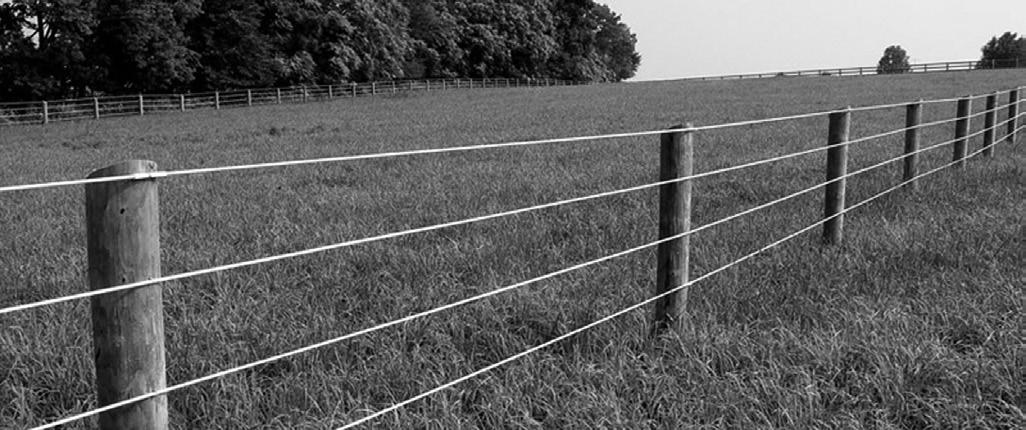
to combine.
Place the bacon in a 10-inch cast iron or oven-safe nonstick skillet over medium heat and cook until crispy, about 7 minutes. Using a slotted spoon, transfer the bacon to a medium bowl. Add the potatoes to the pan, spread into a single layer, and cook for 3 minutes.
Add 1/2 cup water. Cover, reduce the heat to medium-low, and cook the potatoes until slightly softened, 3 to 5 minutes. Transfer the potatoes to the bowl with the bacon. Pour off any remaining water and dry the pan.
Add 1 tablespoon canola oil to the pan and return to mediumlow heat. Pour in half the egg mixture and let cook undisturbed until the bottom begins to set, about 3 minutes.
Sprinkle with half of the bacon and potato mixture, half the scallions, and half the cheese. Pour the remaining egg mixture on top and shake the skillet to settle the mixture. Sprinkle with the remaining potato and bacon and scallions. Shake the skillet again, then sprinkle with the remaining cheese. Cook undisturbed until the eggs at the edges of the skillet begin to set, about 2 minutes.
Transfer the skillet to the oven and bake until the eggs are just set and the edges are golden-brown and come away from the pan, about 15 minutes. (The center should no longer jiggle.)
Heat the broiler to HIGH and broil until the top of the frittata is lightly golden-brown in spots, 1 to 2 minutes. Let cool in the skillet for 5 minutes, then slice into wedges and serve warm or at room temperature.
Egg Salad thepioneerwoman.com
1/2 cup mayonnaise
2 tablespoons yellow mustard
1 tablespoon dill pickle juice
1/2 teaspoon kosher salt, plus more to serve
1/4 teaspoon ground black pepper, plus more to serve
1/4 teaspoon paprika, plus more to serve
1/8 teaspoon cayenne pepper, optional
12 whole hard-boiled eggs, peeled
1/4 small red onion, finely chopped
1/4 cup finely chopped dill pickles
1 tablespoon chopped fresh chives, plus more to serve
1 tablespoon chopped fresh dill
Sliced bread or crackers, for serving
In a medium bowl, whisk together the mayonnaise, mustard, pickle juice, salt, pepper, paprika, and cayenne until well combined. Coarsely chop the hard-boiled eggs; fold into the dressing with the onion, pickles, chives, and dill. Cover and refrigerate the egg salad until ready to serve.
Sprinkle the salad with extra chives, salt, pepper, and paprika. Serve on sandwiches, on crackers, or straight from the bowl.
Classic Deviled Eggs
Bettycrocker.com
6 hard-cooked eggs, peeled
3 tablespoons mayonnaise or salad dressing
1/2 teaspoon ground mustard
1/8 teaspoon salt
1/8 teaspoon pepper
Paprika, if desired
Cut eggs lengthwise in half. Slip out yolks and mash with fork. Stir in mayonnaise, mustard, salt and pepper. Fill whites with egg yolk mixture, heaping it lightly. Sprinkle with paprika, if desired. Cover and refrigerate up to 24 hours.
Variations:
Bacon-Cheddar Deviled Eggs: Mix 2 to 3 crumbled crispy bacon slices and 2 tablespoons finely shredded cheddar cheese into the yolk mixture. Garnish with more crumbled bacon or chopped fresh chives or parsley.
Chipotle Deviled Eggs: Omit the mustard. Stir 1 thinly sliced green onion and 1 1/2 to 2 teaspoons finely chopped, drained chipotle chiles in adobo sauce (from a 7-oz can) into the yolk mixture. Garnish with chopped fresh cilantro leaves and a sprinkle of chili powder.
Diane Lochner is a librarian and home cook, living on a century farm in southern Minnesota. Reach her at 507bookcook@gmail.com v
Leopold Award taking nominees
The Leopold Conservation Award honors farmers, ranchers, and forestland owners’ efforts in management of soil health, water quality and wildlife habitat on working land.
Nominations may be submitted on behalf of a landowner, or landowners may apply themselves.
The application deadline date is July 1. Applications must be emailed to award@sandcountyfoundation.org
The award recipient receives $10,000, and their conservation success story will be featured in a video and in other outreach.
Given in honor of renowned conservationist Aldo Leopold, the award recognizes landowners who inspire others with their dedication to environmental improvement. In his influential 1949 book, “A Sand
County Almanac,” Leopold called for “a land ethic,”
an ethical relationship between people and the land they own and manage.
The Minnesota Leopold Conservation Award is made possible through the generous support of American Farmland Trust, Minnesota Soil Health Coalition, Soil Regen, Sand County Foundation, USDA Natural Resources Conservation Service, General Mills, Audubon Minnesota, Minnesota State Cattlemen’s Association, Minnesota Corn, Minnesota Department of Agriculture, Minnesota Ducks Unlimited, Minnesota Farm Bureau, Minnesota Farmers Union, Minnesota Wheat Research & Promotion Council, Pheasants Forever, Renovo Seed, Saddle Butte Ag Inc., and The Nature Conservancy.
This article was submitted by the Sand County Foundation. v
507-956-2657 SOUTHWEST MINNESOTA CUSTOM FENCE BUILDERS Daniel & Terese Hall 40133 - 620th Ave. Butterfield, MN 56120 PAGE 6 www.thelandonline.com — “Where Farm and Family Meet” THE LAND — APRIL 12, 2024
Wide variety of lilies available are not just for Easter
White lilies (Lilium Longiflorum) are the traditional potted Easter flower sold in full bloom. Since the end of World War II, this plant has been grown in coastal southern Oregon and northern California.
The name means “long flowered” and refers to the shape of the trumpet flowers.

GREEN AND GROWING
By Linda G. Tenneson
Under perfect conditions, these natives from Japan can grow from seed to flower in six months. After Easter or the last frost, lily pots may be set outdoors until fall. However, they are unlikely to bloom again because they have been forced — and this depletes the bulb’s energy.
If planted outdoors, tip the pot upside down while supporting the bulb and stem with your hand. This means spreading your fingers and
placing the stem in between the second and third fingers with the palm supporting the bulb as much as possible. The root ball should slide out of the pot. Rough up the outer surface of the root ball so that the roots which may have reached the pot wall and then grown in a circle, will then spread out into the surrounding soil.
Plant in full sun for at least six hours per day and water as needed during the growing season. The lily should be repotted and brought indoors before frost. Or you may store the bulb in a cool location till spring and then replant it outdoors. It is less likely to bloom a second season.
Gardeners who love lilies have many species to choose from that will survive and flower year after year in our
Treatment for invasive plants varies
While it’s still fairly quiet in the plant world compared to our main summer growing season, it’s a great time to get started on controlling some invasive plant species.
Invasive plant management occurs throughout the year and depends on the growth, habit, and lifecycle of the species. Plant types include woody, herbaceous annual, herbaceous biennial, or herbaceous perennial plants.
Spring is a great time to pull garlic mustard before it seeds. It’s also a good time to use prescribed fire to burn invasive plants before many native prairie plants emerge.
Summer months are ideal for controlling plants that are accessible and actively growing but haven’t produced seed yet, such as spotted knapweed.
Fall is a good time to spray herbaceous biennials and perennials because they will move herbicide along with
carbohydrates into their roots as they store energy for spring emergence.
In the winter, while herbaceous plants are dormant, it can be advantageous to cut and treat woody vines such as roundleaf bittersweet.
While accessibility is one planning factor for treatment, there are numerous other considerations. Know which treatment method will be most effective depending on the lifecycle stage of the plant. Spray outside of the plant’s bloom window to avoid spraying pollinators. Another way to avoid pollinators is to spray early in the morning before pollinators are active.
It is always important to have the correct materials, equipment, and sufficient time to complete a treatment thoroughly.
This article was submitted by Maya Sarkar, Minnesota Department of Agriculture.
Midwest gardens. Purchase and plant lily bulbs in the fall about three times the height of the bulb, usually six to eight inches deep. Full sun to light shade and follow the mantra, “warm faces and cool feet.” This means that lily plants prefer to have their roots shaded or in cool, well-drained soil. Place shorter plants with dense foliage in front of the lilies and they will grow best.
Lilies that are sold as “tree lilies” are simply varieties that grow tall. They are not a separate lily species.
Asiatic lilies have blooms that face up, and come in full size (one to five feet tall), or dwarf varieties. They are not fragrant. They bloom in early to mid-June and come in every color except blue. And they may be bicolored with freckles on the petals.
Oriental lilies are fragrant, and bloom after the Asiatic lilies have finished. The blooms may be white, pink, crimson or pale yellow and may grow up to six feet tall. The blooms face outward.
Another fragrant variety are the
trumpet lilies which bloom about the same time as the Orientals. Their long blooms face outward and are usually white, yellow or pale pink.
The traditional Easter lily is a trumpet lily.
Shoppers looking for lilies will find numerous hybrid cultivars. Orienpet hybrids are a common one and are a cross between oriental and Chinese trumpet lilies. They have large fragrant blooms, which are often ten inches across.
The University of Wisconsin has a detailed article, www.extension.wisc. edu/articles/easter-lily-lilium-longiflorum. South Dakota State University also has an excellent article https:// extension.sdstate.edu/its-easter-lilytime. The Chicago Botanic Garden website www.chicagobotanic.org/ plantinfo/lilies has recommendations for lilies that will bloom in each summer month and blog posts on various lily subjects.
Linda G. Tenneson is a University of Minnesota master gardener and tree care advisor. v
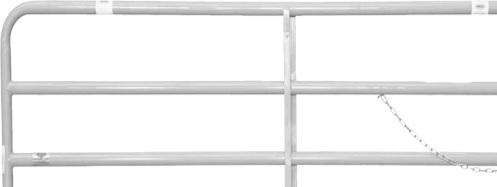

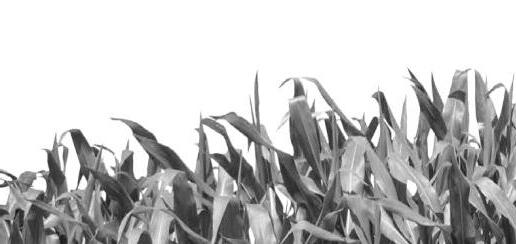



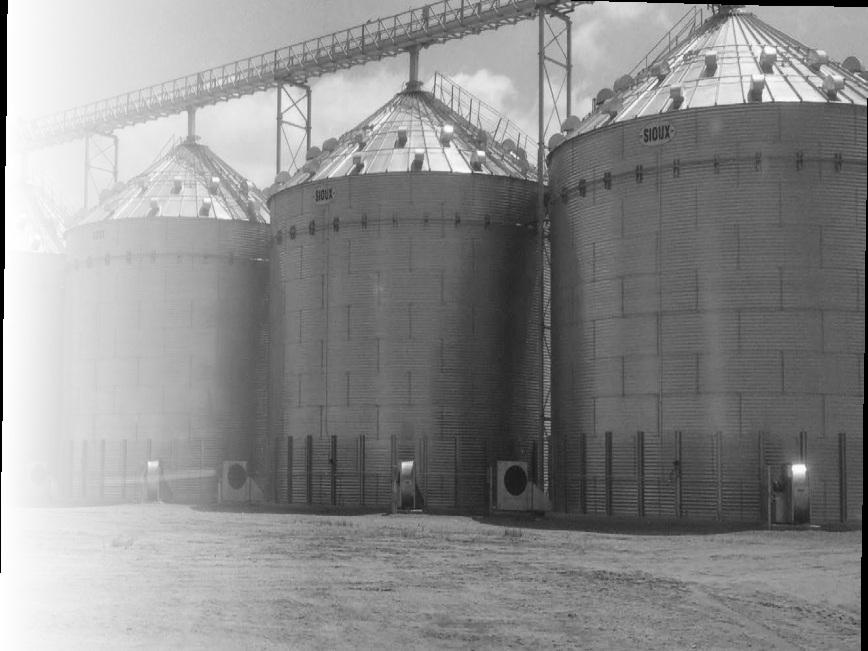
GRAIN SYSTEMS & LIVESTOCK EQUIPMENT GATES •PANELS •WATERERS •CALVING PENS HAYFEEDERS •MINERAL FEEDERS •WORKING EQUIPMENT Schlauderaff Implement Co 320-693-7277 60240 US Hwy 12 Litchfield, MN 55355 • www.schlauderaffimp.com Store Grains Up to 64 LBS PerBushel! Replaceyour existing gateswith Sioux Steel 2” Victor yGates.Theycome standardwith LIFETIMEWARRANTIES! 10 Year Farm BinWarranties •RoofPeak Load Ratings Up To 10,000 lbs. THE LAND — APRIL 12, 2024 www.thelandonline.com — “Where Farm and Family Meet” PAGE 7 Join The Land Online! www.thelandonline.com Facebook.com/TheLandOnline
v
Vilsack to Congress on new Farm Bill: ‘Get serious’
from pg. 2
Water retention aside, DeJongHughes said conservation tillage plays a big role in erosion control.
Unprotected soil with high clay content can travel “thousands of miles” in the wind, she said, which is visible in road ditches throughout the countryside. “A heavy rain droplet can throw soil three feet,” she went on to say. “If your field is on a downhill slope, five feet.”
DeJong-Hughes said disk tillage, a practice commonly used, compacts the soil, destroys soil structure and buries more field residue. “The compaction goes three to four feet deep,” she said. “The best use for a disk? Construction roadwork.”
Vertical tillage is a better option, DeJong-Hughes went on to say, but the coulters need to be straight up and down with no more than a five percent tilt. “You can get into a wet field sooner with vertical till, but weeds come in fast. You can also go fast with vertical till, but it throws dirt like crazy.”
Strip tillage disturbs only about a third of the soil, she said, and could be the best tillage option for corn. “Shanked strip till units are best for full use,” DeJong-Hughes said. “It cuts residue and moves it out of the way for planting and has potential for one pass. Rock trippers allow the shanks to move when you hit a rock.”
There are also coulter strip till units which create a wider planting area and “work great in sandy soil.”
“Farmers are having success with LAND
fall strip tillage,” DeJong-Hughes continued. “The soil warms fast in the spring and fall tillage allows farmers to split the workload between fall and spring.”
Economically, DeJong-Hughes said less tillage saves fuel, money and time. “Seed hybrids are better, planters are better — you don’t need all that tillage. You can also use a smaller tractor than you would need for diskrip tilling. You also don’t need a chopping head on combines.”
DeJong-Hughes concluded by saying an equipment rep can help set up a strip tiller to meet a farmer’s personal needs, depending on soil types and crop rotations. There may also be costshare programs available through regional watersheds and county Soil and Water Conservation Districts.
Finally, Mankato had a bit of a brush with fame when U.S. Secretary of Agriculture Tom Vilsack made an appearance at MSUM on April 3. State highway patrolmen and men in suits with earpieces milled around the school’s student union as many of the region’s big ag players took in the event.
Vilsack announced the availability of $1.5 billion in fiscal year 2024 to invest in partner-driven conservation and climate solutions through the Regional Conservation Partnership Program (RCPP) as part of President Biden’s Investing in America agenda. The U.S. Department of Agriculture is accepting project proposals now through July 2 that will help farmers, ranchers, and forest landowners adopt

and expand conservation strategies to enhance natural resources while tackling the climate crisis.
Vilsack spoke of the current trend of consolidation of farm income. Onethird of U.S. farms are owned by investors. Ten percent of the farms in the United States receive 85 percent of the country’s farm income. “1.5 million farms share 11 percent of farm income,” he said.
To help counter a steady loss in the number of farms in the United States, and bring new people into farming, Vilsack said it is vital to create multiple sources of farm income. This includes bio-products — especially those generated from ag waste. More farms need to take advantage of renewable energy sources such as wind and solar. Vilsack said less than 1 percent of U.S. farms currently take advantage of these cost savings. He also added there needs to be more onfarm processing of ag products and more local food distribution instead of trucking commodities over long distances.
Vilsack also touched on the potential of carbon markets supplementing farm income.
Unless changes are made, Vilsack said, the disappearance of family farms will continue to sap the nation’s rural economy: fewer schools, fewer hospitals and medical clinics, fewer stores and small businesses. “This is not just about farmers. It’s about all of us.”
After Vilsack’s presentation, he joined a panel of ag leaders from around the state to talk about the current condition of various commodities. Joining Vilsack were Minnesota Department of Agriculture Commissioner Thom Peterson; Harold Wolle of the National Corn Growers Association; Lori Stevermer of the National Pork Producers Council; Bob Worth of the Minnesota Soybean Growers Association; farmer Grant Bruetkreitz; MSUM’s Megan Roberts; Jes Westbrock of the Minnesota Turkey Growers Association; and
dairy farmer Steve Sjostrom. Biofuels, the Farm Bill quagmire and California’s Proposition 12 were some of the top discussion points and Vilsack made it clear he has little influence over Congress and ag legislation. He did, however, commiserate with the panel members and their issues. “The Supreme Court doesn’t understand the pork industry,” he told Stevermer. “The people of California have every right to raise pigs however they want, but it shouldn’t affect the entire country. Minnesota doesn’t tell California how to produce wine.”
Vilsack was also candid about the Farm Bill. “The only way to get the Farm Bill done is finding additional money,” he said. Vilsack added Farm Bill progress is being stalled by fiscal conservatives in Congress — including a large number who want to eliminate export assistance programs. “Eventually they have to get serious about this.”
No one on the panel brought up China, so Vilsack did. “There are nuances in dealing with China and we have to use caution,” he said, mentioning China’s land ownership in the United States, our country’s reliance on computer chips, and our need to have China as a customer.
“If we want to sell to China,” Vilsack stated, “we have to be less confrontational.”
No real new ground was broken during Vilsack’s visit, although the Secretary did comment the recent discovery of HPAI in dairy cows was “sensationalized.” At the same time, the re-election of Vilsack’s boss was minimalized which was a pleasant surprise.
The 2024 RCPP funding priorities are climate-smart agriculture, urban agriculture, conservation, and environmental justice. How this trickles down from Washington D.C. to actually make a difference for today’s farmers remains to be seen.
Paul Malchow is the managing editor of The Land. He may be reached at editor@TheLandOnline.com. v
PAGE 8 www.thelandonline.com — “Where Farm and Family Meet” THE LAND — APRIL 12, 2024
MINDS,
For more news briefs, visit the “Nuts and Bolts” section at www.TheLandOnline.com
Give trees a good start with proper planting
Trees provide so much to our environment; beauty, energy conservation, reduction of soil erosion, filtering air pollutants, raising property values, a home for wildlife and so much more. Trees are an integral part of our home landscapes, neighborhoods and countryside. If you are looking to plant a tree, there are a few things you will want to keep in mind.
The most common mistake when planting trees today is planting too deep. Many purchased trees have the root flare buried in the root ball or pot. (The root flare is the area where the roots meet the trunk — commonly identified by a flaring of the trunk.) If this excess soil is not removed, the root flare suffocates from excess soil — resulting in a disruption of water and nutrient uptake, starting a downward
spiral for the tree. It can also result in the tree roots wrapping around the trunk and eventually girdling the tree.
To ensure your tree is not planted too deep, do not follow the common recommendation of planting the tree at the same soil level that it currently has. Instead, remove the soil until you find the flare. You may need to remove as much as 9 inches of soil. Then, make sure the bottom of the collar is above ground level.
When digging the hole for your tree, dig the hole only as deep as the root ball, after finding the root flare, and no deeper so the soil under the root ball is undisturbed. This will prevent the tree from settling.
Calendar of Events
Visit www.TheLandOnline.com
April 17 — I-29 Moo University Webinar — Online
— This webinar will feature a discussion on fly control with Dr. Philip Jardon. The talk will cover the four main flies that are considered pests on dairies — house flies, stable flies, horn flies, and face flies. Contact Fred Hall (Iowa) at (712) 737-4230 or Jim Salfer (Minnesota) at (320) 203-6093.
April 17–19 — PEAK 2024 — Minneapolis, Minn.
— This poultry-focused trade show will have exhibits and opportunities for education and networking. For
more information, email info@midwestpoultry.com or call (763) 284-6763.
April 23 — Garden Magic — Hutchinson, Minn.
— Event will include discussions on container gardening through the seasons and coordinating perennials to ensure color throughout the seasons. Contact the McLeod County Extension office at (320) 484-4302.
May 9 — I-29 Moo University Webinar — Online
— This webinar will focus on crossbreeding for improved health and profitability on dairy farms. Dr. Brad Heins will lead the discussion. Contact Fred Hall (Iowa) at (712) 737-4230 or Jim Salfer (Minnesota) at (320) 203-6093.
Apply now for Beginning Farmer Institute
NFU’s Beginning Farmer Institute is a free, online, 10-week intensive program intended to improve the health of your farm or ranch business. The program is open to producers ages 18 and up and is inclusive of all operation types and scales of production.
Accepted participants will attend online seminars, network with peers, pursue independent learning activities, and receive one-on-one technical assistance. Participants who complete all the necessary requirements will be considered for an additional in-person session, which will include additional trainings, farm tours, and networking with Farmers Union leadership.
The program is structured around weekly online trainings led by experts in business management. Over the course of 10 weeks, participants will be expected to watch 30-60 minutes of video trainings each week, followed by participation in weekly, 2-hour Q&As with subject-matter experts.
Program objectives include business formation, taxation, accounting, credit, business planning, labor, land and insurance.
Each participant will receive a one-year member-
ship to Farm Commons, a Farmers Union membership and direct technical assistance with the opportunity to schedule a one-on-one meeting with the instructor to ask questions about their individual situations.
Applicants must be 18 years or older, must be a resident of the United States or Puerto Rico, and should be currently farming/ranching or planning on starting within the next year. The farming operation must be for-profit (the institute content is not suitable for non-profit operations).
To apply, each applicant must submit the application (online or print), along with a current resume (no longer than one page), one reference letter in support of your candidacy, and a two- to three-page essay describing your current farm or ranch operation, how you envision your operation in five years, and how participating in the Institute will help you achieve this.
Applications are due by July 1 and can be found at www.nfu.org/bfi.
This article was submitted by the Minnesota Farm Bureau.
Dig the hole two to three times as wide as the root ball. This will allow roots to grow more easily outwards.
Do not add soil amendments. Old recommendations for adding soil amendments such as peat moss have been discarded. Simply use the soil removed from the hole as backfill.
Watering a newly planted tree is extremely important to ensure it establishes and stays healthy for years to come. Newly planted trees need to be watered daily for the first two weeks; three days a week for next 12 weeks and once a week until the roots are established.
You can figure out how long it will take for the roots to establish and how much water your tree needs at each watering by measuring the tree’s caliper (or diameter of the trunk). For younger trees, take the caliper measurement at 6 inches above the ground. For a tree whose caliper is greater than 4 inches, measure at 12 inches above the ground. For each inch of caliper, your tree will take 1.5 years to establish and 1.5 gallons of water at each watering.
You may want to add some wood chips or other mulch around the base of your tree. Mulch helps to conserve soil moisture and eliminates competition from turf. However, if it is mounded up and in contact with the trunk it will ultimately cause more issues than it fixes. Mulch should not look like a volcano at the bottom of your tree. Avoid using rock, landscape block and landscape fabric around your tree.
Do not wrap trees during the growing season. Wrap can hold moisture next to the trunk and serve as a home for insects. Some wraps can also cause sun damage to the trunk of the tree which is harmful. Wraps can be used in the winter to protect from deer and other wildlife damage.
Finally, be sure to consider the tree’s mature height and breadth when choosing its planting location. You would hate to need to remove your tree in a few years because it is planted too close to your house or growing into a power line.
This article was submitted by Katie Drewitz, University of Minnesota Extension. v



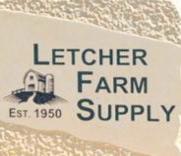
LETCHER FARM SUPPLY
INC MINN ESOTA’ S LOW PRIC ED AG CHEMICAL DEALER Chemicals ~ Fertilizers ~ Seeds Call for current Chemical prices (507) 549-3168 or 549- 3692 www.letcherfarmsupply.com Serving Minnesota Farmers Herbicide Needs since 1950! Call for Current Chemical Prices THE LAND — APRIL 12, 2024 www.thelandonline.com — “Where Farm and Family Meet” PAGE 9
,
v
to view our complete calendar and enter your own events, or send an e-mail with your event’s details to editor@thelandonline.com.
Have a discussion on virus, bacteria and healthy pigs
A few summers ago, two University of Minnesota Extension colleagues and I hit the road with the University’s BEET (Biosecure Entry and Education Trailer) teaching 4-H members and their families the basics of biosecurity. Pig folks had already heard the term, and we had a great time working with all 4-H livestock exhibitors, showing them how easy it could be to prevent disease in their animals. And conversely, how easy it is to spread virus and bacteria from people and equipment to animals.
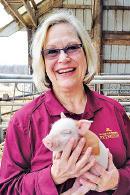
SWINE & U
By Diane DeWitte
Exhibitors are currently picking out pigs for the summer’s shows, and it’s time to review some of the key points to keep the pigs healthy — in addition to youth and their families.
When preparing pigs for show, quarantine new pigs for 14-30 days after you bring them home. Do not mix them with “home” pigs until the time has passed and you know that they are healthy. Get recommended vaccinations for your pigs, monitor them for illness or health challenges and communicate with a veterinarian quickly should they occur. Clean and disinfect pens and equipment regularly and do not share equipment with others. Clean and disinfect trailer before and after each use. Control pets, pests and wildlife around your pigs and isolate animals after an exhibition.
Viruses
Viruses occur in all species and can move very well between animals, which is one reason that quarantine of new animals is important. In the case of Zoonotic diseases (diseases which can infect both people and pigs) it’s critical to exclude the virus.
Limit or eliminate visitors to your pigs. Viruses can be carried on clothing, shoes, and equipment. Ask and know where your visitors have been, and do not allow anyone near your pigs who has pigs of their own, or who has recently traveled abroad. Make sure everyone wears clean clothes and shoes when working with your pigs. Do not feed uncooked garbage or swill to your pigs and make sure your pigs are vaccinated against common viral diseases.
A study from the University of Minnesota’s College of Veterinary Medicine showed that people who worked with pigs could reduce spread of the virus by using personal protective equipment or practicing simple sanitation when moving between pig sites.
The study illustrated the value of “high biosecurity” (shower and complete change of clothes/footwear) and “medium biosecurity” (washing hands and face, plus changing footwear) in preventing the spread of PED virus among pigs. In both “high” and

“medium” biosecurity groups, no pigs in the study became infected.
The “low biosecurity” group of pigs (caretakers did not change clothes or wash exposed skin when moving between pig groups) became infected within the first two days of the study. The entire study can be found online at https://z.umn. edu/2017BiosecurityStudyUMN.
Practices as simple as handwashing, wiping face, changing boots, stepping through a boot bath, and changing coveralls are proven to help prevent the spread of the virus to pigs and between pigs.
Humans can protect themselves by always washing their hands after working with animals. Do not eat or drink in the livestock area.
Bacterial infections
U of M swine researchers focus a lot of attention on the viruses that affect pigs, but we continue to face bacterial infections. Bacterial disease discussions below are from Dr. Perle Zhitnitskiy’s “Swine Diseases” textbook. I’m highlighting these three in particular because of their effect on young pigs — particularly those pigs the size of the new show pigs that exhibitors may be acquiring.
Streptococcus suis can cause disease in all ages of pigs, is common in every pig-raising country, and is found in the upper respiratory tract. It is considered an emerging zoonosis with the number of human cases rising in recent years — especially in Asian countries. Disease prevalence is usually only 5 percent of the pigs affected — even if there may be 100 percent carriers. Transmission usually is nose-tonose contact between pigs.
Escherichia coli (E. coli) is the cause of various symptoms in all stages of pigs, from diarrhea to urinary tract infection. The F18 strain affects 10 to 12-week-old pigs, and, contrary to other strains, is characterized by neurological symptoms rather than diarrhea. Many times, there is 50 to 90 percent mortality in nursery-age pigs. Pigs typically come into contact with the bacteria through a contaminated environment or due to fecal-oral transmission.
Glaesserella parasuis is a long-recognized bacteria which until 2020 was known as Haemophilus parasuis (it was renamed after the man who discovered it). G. parasuis is one of the main pathogens of importance in nursery pigs. It causes inflammation of lubricating surfaces in internal organs, and lameness. The bacteria are found in the upper respiratory system, but piglets first contract it when nursing the sow for colostrum. Nursing pigs also receive maternal antibodies against disease. Poor management practices that disrupt the balance between antibody protection and bacterial load cause the development of clinical signs.
Signs of the acute form of Glaesserella parasuis infection are first fever, followed by paddling, lameness, swollen joints and trouble breathing.
Acute Streptococcus suis infection symptoms include fever and depressed behavior, followed by signs of meningitis, including paddling, head tilts and lack of coordination.
Sick pigs will be too weakened to get up and consume medicated feed or water. In each of these bacterial infections, the most severe outcome is unexplained death of the pig.
Treatment of these bacterial infections can be successful if pigs are injected with antibiotics. Bacterial disease development can be prevented by good management and sanitation practices. Most of these bacteria do not survive well in the environment.
Good ventilation and cleaning and disinfection of the barn and equipment is critical in controlling the bacteria population. Prevention of wide temperature variance helps prevent disease outbreaks.
In the case of F18 E.coli, a lineage of pigs that are resistant to the disease has been developed. Recently, researchers at Iowa State University performed whole-genome sequencing of submitted G. parasuis isolates and are determining specific serotypes for production of autogenous vaccines and replacement animal selection.
Cleaning and disinfection is critical
Whether dealing with bacteria or viruses, sanitation of the barn, feed and water equipment, pens, and truck and trailer is an important step in breaking the cycle.
Always move pigs in a clean trailer and thoroughly clean show equipment, feeders, and waterers between shows. Mindful cleaning can prevent transmission of all common swine disease pathogens. Remove all manure, bedding and organic matter from the trailer and dispose of it away from your home barns, pens and pig lots. Thoroughly wash inside and outside of livestock trailer. Wash outside of truck along with wheels and tires. Wash out the wheel wells of both truck and trailer. Disinfect inside and outside of trailer. Clean inside truck cab. Disinfect floor mats and wipe down cab interior with disinfectant wipes labeled for surfaces.
General disinfectants for transport, equipment or barn surfaces include Tek-Trol Disinfectant, 1-Stroke Environ Germicidal, Synergize or Virkon-S. Use according to label directions. Another suitable disinfectant is a bleach solution of 1:10 parts bleach and water; or 3/4 cup of bleach per one gallon of water.
Diane DeWitte is a University of Minnesota Extension Educator based in Mankato. She can be reached at stouf002@umn.edu.
PAGE 10 www.thelandonline.com — “Where Farm and Family Meet” THE LAND — APRIL 12, 2024
v
SWINE&U UniversityofMinnesota EXTENSION
USDA confirms detection of HPAI in dairy herd
The U.S. Department of Agriculture’s Animal and Plant Health Inspection Service reported they have confirmed the presence of HPAI in a New Mexico dairy herd and five additional Texas dairy herds. As of April 3, there have been confirmed detections of HPAI in dairy herds in Texas (7) Kansas (2), Michigan (1), and New Mexico (1).
The USDA announcement stated there continues to be no concern that this circumstance poses a risk to consumer health, or that it affects the safety of the commercial milk supply because products are pasteurized before entering the market.
Federal and state agencies continue to conduct additional testing in swabs from sick animals and in unpasteurized clinical milk samples from sick animals, as well as viral genome sequencing, to assess whether HPAI or another unrelated disease may be underlying any symptoms.
As of April 3, impacted herds have not appeared to be experiencing mortalities associated with this disease syndrome. In impacted herds, approximately 10 percent of cattle are affected, with the majority of cases being mid to late-lactation mature cows. Impacted herds are experiencing approximately 10 to 20 percent reduction in milk production for a 14 to 21-day period. Dry cows, fresh cows, heifers and calves do not appear to be affected.
Affected cattle have symptoms that last between 10 and 14 days with the worst of the symptoms peaking in the first 3 to 5 days. There is a sudden drop in milk production, with severe cases producing thicker, more concentrated milk that appears colostrum-like. Affected cattle will have a drop in feed intake and rumination activity and can experience secondary infections including pneumonia and mastitis.
If you feel your herd’s symptoms are consistent with the reported illness, consult with your herd veterinarian or the Minnesota Board of Animal Health (www.bah.state.mn.us/) immediately.
Based on these cases, cattle (dairy and beef) owners are encouraged to follow recommended biosecurity practices for mitigating livestock and avian interaction. Minimize or eliminate (when possible) poultry and livestock species access to ponds, wetlands, and other stagnant water sources frequented by wild waterfowl (ducks, geese, swans). Monitor domestic poultry for illness. This includes reduced appetite, reduced water intake, and unexplained deaths. Monitor cats, wild waterfowl, and wildlife that are frequently found around livestock facilities for illness or unexplained deaths. Farmers might also consider housing poultry separately from other livestock species and minimize poultry access to pasture areas that are grazed by other livestock species. Minimize or eliminate (when possible) poultry, waterfowl, and wildlife access to potentially shared water sources and feedstuffs (e.g., cover and secure feed piles).
As of April 3, it was unclear if the illness can be spread from cow to cow or by inanimate objects such as vehicles or equipment. Cattle (dairy and beef)
CDC reports a person has tested positive for highly pathogenic avian influenza
Centers for Disease Control and Prevention announced that a person in the United States has tested positive for highly pathogenic avian influenza (HPAI). The person had exposure to dairy cattle in Texas presumed to be infected with HPAI. The person was reported to have mild symptoms and is recovering.
This is the second person reported to have tested positive for influenza A(H5N1) viruses in the United States. A previous human case occurred in 2022 in Colorado.
Human infections with avian influenza A viruses, including A(H5N1) viruses, are uncommon; but have occurred sporadically worldwide. CDC has been monitoring for illness among people exposed to H5 virus-infected birds since outbreaks were first detected in U.S. wild birds and poultry in late 2021.
If you are working directly with cattle that have tested positive or are suspected to be infected and you are experiencing flu-like symptoms, consult your physician. Human cases of influenza must be confirmed with testing. They cannot be diagnosed based on symptoms alone.
The most common symptoms include fever or feeling feverish, cough, sore throat, runny or stuffy nose, muscle or body aches, headaches, fatigue, eye redness (or conjunctivitis) and shortness of breath or difficulty breathing. v
owners are encouraged to limit farm visitors and minimize the interaction of on-farm vehicle routes and off-farm vehicle routes. Ensure the equipment used to transport animals (i.e. trailers) is clean and washed between uses. Cattle transported to a new premise should be quarantined and isolated for 21 days to monitor for clinical signs before joining the herd. Deceased animals should be disposed of promptly and appropriately to prevent wildlife interaction with the carcass, or rendering. Minimize the interaction of the rendering truck with on-farm vehicle routes and animals.
When possible, farm personnel should have dedicated clothing, boots, and other personal protection equipment for the farm that stays on the farm. Service providers are encouraged to have dedicated equipment as well as clothing, boots, and other PPE for farms they visit regularly. Boot washing and disinfection, equipment washing and disinfection, and changing soiled clothing are recommended when dedicated equipment is not possible.
Milk intended for consumption by animals, including calves, from cows that are infected or have potential contact with infected animals, should be pasteurized. For updates, continue to check the University of Minnesota Extension website (exension.umn.edu/ news), the USDA APHIS website (www.aphis.usda. gov/), the Minnesota Board of Animal Health website (www.bah.state.mn.us/), and the Center for Disease Control website (www.cdc.gov/media/archives.html).
This article was submitted by Joe Armstrong, DVM, University of Minnesota Extension and Tim Goldsmith DVM, MPH, University of Minnesota College of Veterinary Medicine. v

THE LAND — APRIL 12, 2024 www.thelandonline.com — “Where Farm and Family Meet” PAGE 11
Data is the key to carbon payments for farmers
By PAUL MALCHOW The Land Managing Editor
As big industry scrambles to become carbon neutral, companies such as Disney, Microsoft, Delta Airlines, Samsung and Google are offering payments to farmers for incorporating practices which sequester carbon dioxide. These practices may include building healthy soil and preventing erosion; minimizing air and water pollution; and promoting biodiversity.
But varying contracts, payments and conditions are proving to be (perhaps purposely) confusing; preventing many farmers from participating in carbon programs. Mitchell Hora offers one key word to prepare farmers for the burgeoning carbon market: data.
But first, let’s differentiate between carbon neutrality and net zero emissions. The United States has committed to attaining “net zero” status by 2050. This may seem off in the distance, but our country has also committed to a 50 percent reduction in emissions by 2030 — which is a lot closer. To reach net zero, the greenhouse gases emitted into the atmosphere must be equivalent to the greenhouse gases being removed from the atmosphere. These gases include carbon dioxide, along with other gases such as methane, nitrous oxide and hydrofluorocarbons.
Carbon neutrality is reached when the same amount of carbon dioxide is released into the atmosphere as is removed by various means, leaving a zero balance, also known as a zero carbon footprint.
So when businesses speak about becoming carbon neutral, it means they’re taking steps to remove the equivalent amount of carbon dioxide to what’s emitted through activities across their supply chains. Since a company like Delta Airlines leaves behind
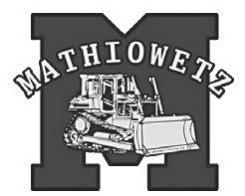
a heavy carbon footprint, they look to offset their carbon dioxide output by investing in ‘carbon sinks’ that absorb carbon dioxide.
One solution to removing carbon dioxide is to pipe it to a location and storing it deep underground. As with many pipeline projects, this plan faces a number of environmental and land acquisition challenges. Some pipeline projects have already been scrapped or scaled back.
Because the photosynthesis in plants involves the absorption of carbon dioxide, and there is approximately 880 million acres of farm land in the United States, the other avenue being explored is paying farmers for carbon credits.
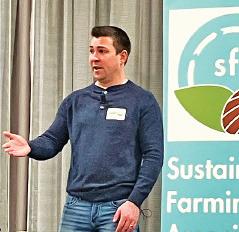
Of course, farms have a carbon footprint of their own — called carbon intensity. But practices such as growing cover crops, reduced tilling, planting windbreaks and rotational grazing can result in a low, or even negative, carbon intensity. This is the zone corporations are interested in buying. Which brings us back to Mitchell Hora.
Hora founded Continuum Ag in 2015 as an agricultural consulting company, specializing in the Haney Soil Health Test.
The Haney test was developed by Rick Haney of United States Department of Agriculture-Ag Research Service in Temple, Texas.
The Haney test uses soil extracts in the lab to determine what quantity of soil nutrients are available to soil microbes. This test also evaluates soil health indicators such as soil respiration, water-soluble organic carbon and organic nitrogen and their ratio. (Soil respiration is a measure of the carbon
dioxide released from soil. It is released as a result of decomposition of soil organic matter and plant litter by soil microbes and through plant roots and soil fauna.) These results indicate the amount of food that is readily available to soil microbes and is sensitive to measuring root exudates and decomposed organic material.
A soil health score is calculated based on soil respiration and water extractable carbon and nitrogen. This score can be used to compare a specific soil location over time or compare between different site management practices.
Section 45Z allows sizable tax credits to ethanol plants who consume low Carbon Intensity grains. The tax credit value to an ethanol plant is 2 cents per Carbon Intensity point below a baseline Carbon Intensity Score (as long as some stipulations are met). One potential way biofuel companies can lower their Carbon Intensity Score is buy low-carbon bushels. Farmers can quantify their on-farm Carbon Intensity Score and for bushels that are carbon neutral (a Carbon Intensity score 0.0), it could be worth as much as 58 cents per gallon of fuel, or nearly $1.57 per bushel in form of a tax credit to the ethanol buyer. There are still many unknowns, including the actual value to the biofuel producer or any potential value created for the farmers.
“All (biofuel) plants need to reduce carbon intensity to qualify for tax credits,” Hora said. “We have no idea what the farmer will get paid; but 6 billion bushels of corn go to ethanol annually, reducing on-farm Carbon Intensity Scores can really lower the overall footprint, providing a big potential for dollars to be shared. Approval details are still being finalized by the IRS. However, it is anticipated that these premiums will be shared with producers. But if you don’t have data verifying a Carbon Intensity Score, you’ll get nothing.”




Continuum Ag uses the U.S. Department of Energy’s Greenhouse Gasses, Regulated Emissions, and Energy use in Technologies (GREET) model to calculate the Carbon Intensity Score of farmers. Each county is given a default Carbon Intensity Score by the Department of Energy. Typically, this score is 29 or so. However, Continuum has scored over 160,000 bushels of corn and found their actual average Carbon Intensity Score to be just 10.6. This score can be lowered with proper regenerative ag management, and tools, like the Haney test, can help make informed decisions.
The Inflation Reduction Act, Section 45Z now assigns a direct value to a Carbon Intensity Score at the biofuel
Hora also anticipates a growing need for oilseed crops for biofuel and sees camelina and canola as valuable cover crop options. “There’s a big push on for renewable diesel and sustainable aviation fuel,” he explained. “The demand I’m hearing is 22 billion gallons a year, so the market will be there.”
Hora doesn’t just pay lip service to soil health. He is the seventh generation to work the family farm in Washington, Iowa. The farm has operated no-till since 1978 and has utilized cover crops since 2013.
Keeping soil covered year-round greatly reduces erosion and helps regulate soil temperature. “On a 91 degree day we were getting a temperature of 100 at the top of the canopy cover,”
An Equal Opportunity/Affirmative Action Employer 30676 County Rd 24 Sleepy Eye, MN. 56085 www.mathiowetzconst.com office@mathiowetzconst.com – Aggregates – Building Pads – Demolition – Ditch Cleaning – Farm Drainage In All We Do, We Do It Right! MATHIOWETZ CONSTRUCTION Farm Friendly Since 1924 507-794-6953 – Grove Removal – Hauling – Site Grading – Terraces – Equipment Sales & Service PAGE 12 www.thelandonline.com — “Where Farm and Family Meet” THE LAND — APRIL 12, 2024 See HORA, pg. 13
production plant.
Photo by Paul Malchow
Continuum Ag founder Mitchell Hora thinks there is a bright future for farmers as industries seek to become carbon neutral. However, Hora stressed, the best farming practices in the world will not be compensated without solid and verifiable data.
Integrating livestock grazing with cover crops boosts benefits
Hora said. “But the temperature at the soil surface was 76 degrees. Where there was bare ground the temperature of the soil surface was 126.”
Hora also found that healthy soil greatly impacts a crop’s ability to tolerate stress — extremely beneficial in recent drought conditions. What rain was received soaked in quickly with literally no run-off. “That first inch of rain soaks in within six seconds,” he said. A key component in building healthy soil is the feeding of soil microbes. In the same way that humans require food, microbes require an energy source to survive and grow their population. Besides using carbon to build their cells, many microbes use carbon-based materials as their energy source as well. In soils, carbon sources available to microbes include plant litter, carbon compounds released by plant roots, and
living or dead soil organisms — including other microbes, worms and insects.
“We dug three feet down and still had black dirt,” Hora went on to say. “Earthworms keep bringing that black soil down.”
The Horas are also seeing a major reduction in input costs. “Our use of insecticides have been reduced 95 percent; fungicides 66 percent. We’ve reduced our nitrogen input from 230 to 155 pounds per acre and phosphorus from 250 to 50 pounds. We used to apply 150 pounds of potassium per acre. That is now zero.”
Solid seeding rye immediately after combining in the fall (about one bushel per acre), the ground has green cover throughout the winter. Soybeans are planted into the rye in the spring. When the rye is ready to harvest, the Horas cut the top 15 inches, leaving the soybeans untouched. “We need to plant
Crop producers urged to utilize DriftWatch, CropCheck
The DriftWatch-CropCheck programs provide a means for crop producers to communicate information about their crop locations and herbicide sensitivity to pesticide applicators. This is done by posting their locations on the DriftWatch/FieldWatch online map. Pesticide applicators can view this information prior to spraying and take needed precautions to avoid drift to sensitive sites.
Some product labels require applicators to check the state’s “sensitive crop registry,” such as FieldWatch, in addition to visually surveying adjacent field prior to making an application. This requirement is on more recent dicamba (Engenia, XtendiMax, Tavium) and 2,4-D products (Enlist Duo, Enlist One).
The herbicide tolerances for field crops are listed by active ingredient. Herbicide tolerance options for corn are: 2,4-D, ACCase (sethoxydim), conventional/non-GMO, glufosinate, and glyphosate. Herbicide tolerance options for soybeans are: 2,4-D, conventional/ non-GMO, Glufosinate, Glyphosate, HPPD (mesotrione), Isoxaflutole, STS (Sulfonylurea).
Once posted on the FieldWatch map,
pesticide applicators can select the icon to obtain crop, herbicide tolerance, and producer information.
If growers are more familiar with herbicide tolerant trait packages rather than herbicide active ingredients, the University of Minnesota Extension has a thorough review of herbicide tolerant traits on their website.
The DriftWatch-CropCheck program is for commercial producers, not home gardens. Sites must be at least half an acre in size.
Crops and herbicide resistances on the FieldWatch map are self-reported and not verified. Also, changes can occur prior to planting and not be updated on the map. Always follow required setbacks and drift control procedures.
For more detailed information on using these programs, refer to the FieldWatch user guide, “How to Register Your Crops and Beehives in FieldWatch.” If you have questions, reach out to your local Extension Educator.
This article was submitted by Katie Drewitz, University of Minnesota Extension.
super full season soybeans to make this work,” Hora admitted, “3.8 to 4.0 RM for southeast Iowa. But we’re also able to plant earlier as the rye protects the beans.”
Hora admitted the window for harvesting the rye without clipping the soybeans is pretty small, which is why they use the practice on a limited number of acres. “Growing with the rye, the soybeans are forced to nodulate like crazy,” he said. “That puts nitrogen in the ground for next year’s corn crop. Last year we got 30 bushels per acre with the rye and 70 bushels per acre with the beans.”
While some rye can remain and mix
in with the soybeans during fall harvest, Hora said they have never been docked for it. “I suppose if you really wanted clean beans you could run it through a screen cleaner.”
Hora also urges — if possible — to integrate livestock grazing with cover crops as the animals’ saliva, urine and manure helps stimulate the soil microbes. “Plant species diversity is key,” he said. “The deeper you can get roots down and keep them alive, the better results you’ll get.”
To learn more about Carbon Intensity Scores and what they can mean for your farm, visit Continuum Ag’s website at https://continuum.ag/. v
FFA Convention April 21-23
MINNEAPOLIS — More than 14,000 students in 218 Minnesota FFA chapters will be celebrated April 21-23 during the Minnesota FFA Association Convention in the Twin Cities.
During the event, roughly 4,000 students enrolled in agriculture, food and natural resource classes in their local junior high and high schools will compete in leadership and career development events reflecting their learnings.
Five general sessions will include award presentations, ending with announcing the six leaders who will take the organization’s reins in 20242025.
The Minnesota FFA Foundation also sponsors an annual Career Connections event for students Monday, April 22, at the Minnesota State Fairgrounds Coliseum from 7:30 a.m. to 12:30 p.m.
New in 2024, all convention attendees including adults will be required to be registered and display a button to
access the convention April 22-23. To pre-register at a $20 charge, contact the local FFA advisor. During the convention, the local advisor should present guests at the registration desk, where a $10 fee will be charged for each general session.
The Minnesota FFA Convention is offered in partnership by the Minnesota FFA Association, the Minnesota FFA Foundation and the Minnesota FFA Alumni and Supporters. Throughout the convention, content is available on the Minnesota FFA website (www. mnffa.org/state-convention), the Minnesota FFA YouTube Channel, on the organization’s Facebook, X and Instagram pages and on the convention app, which will be live just before the convention begins.
This article was submitted by the Minnesota FFA Association. v

Snirts Gettin’ in? We Can Keep em’ Out. Snow • Water • Dirt • Leaves • Critters • Cold HeatBillsareSkyrocketing SAVE UP TO 40% 25YearWarranty Call Today 800-250-5502 or Visit snirtstopper.com SEALS GAPS UP TO 2 INCHES ON YOUR GARAGE & SHOP OVERHEAD DOORS! THE LAND — APRIL 12, 2024 www.thelandonline.com — “Where Farm and Family Meet” PAGE 13
12
HORA, from pg.
v
HPAI discovery won’t hurt dairy demand … for now
This column was written for the marketing week ending April 5.
The dairy industry remains captivated by the diagnosis of highly pathogenic avian influenza (HPAI) found on dairy farms in Kansas, Texas, Michigan, New Mexico, Ohio and Idaho. Analysis is underway for additional presumptive positive tests from herds in Kansas, New Mexico, Ohio and Texas.

MIELKE MARKET WEEKLY
One case has been confirmed by the U.S. Department of Agriculture in Idaho, three in Kansas, one in Michigan, two in New Mexico, one in Ohio, and seven in Texas. Restrictions on dairy cattle movement are in place in Delaware, Idaho, Nebraska, Tennessee and Utah.
By Lee Mielke
ness as their only symptom, and is recovering.”
The U.S. human risk assessment remains low. However, the CDC says, “People with close or prolonged unprotected exposures to infected birds or other animals (including livestock), or to environments contaminated by infected birds or other animals, are at greater risk of infection.”
MARKETING
The National Milk Producers Federation states, “There continues to be no concern about the safety of the milk supply or that this circumstance poses a risk to consumer health because products are pasteurized before entering the market, per the Food and Drug Administration. Only milk from heathy animals is authorized for distribution into interstate commerce for human consumption. Additionally, pasteurization has continually proven to inactivate bacteria and viruses, including influenza, in milk.”
The U.S. Center for Disease Control and Prevention announced on April 1 that a person in Texas tested positive for avian influenza after exposure to dairy cattle presumed to be infected with the H5N1 bird flu. “The patient reported eye red-
HighGround Dairy reports this is actually the second person to have tested positive for influenza A (H5N1) viruses in the United States. A previous case occurred in 2022 in Colorado. The CDC notes that human infections of avian influenza are uncommon but have occurred sporadically worldwide.
Speaking in the April 8 “Dairy Radio Now” broadcast, StoneX broker Dave Kurzawski said no one knows what impact this outbreak will have on the market, but says we have some historical reference. He said Christmas Eve 2003, Mad Cow disease (BSE) was first reported in dairy cows in Washington State and “The cattle markets broke hard over it and the price of cheese went from $1.2975 per pound to $2.20 in April, four months later because other things mattered more.”
“When the U.S. consumer hears cattle, they think beef,” he reasoned. “They don’t necessarily think milk on their cereal or cheese on their pizza, but it’s early in this ongoing situation.”
Kurzawski does not think it will matter much for
Gopher Dairy Camp registration open
ST. PAUL — Registration is now open for the 2024 edition of the Gopher Dairy Camp, which will be held June 20 to 22 at the University of Minnesota - Twin Cities.
The goal of the camp is to provide dairy youth the opportunity to strengthen their dairy knowledge and skills, as well as to network with other dairy youth who share their interests.
Gopher Dairy Camp is open to all youth who have completed grades six through nine, but have not yet started 10th grade. Held Thursday through Saturday, the camp’s agenda offers workshops which will allow attendees to excel in the show ring, improve their fitting skills and grow their knowledge of dairy technology and dairy-related fields.
The primary focus areas of the camp are calf selection, showing preparation of dairy cattle and showmanship. Campers have the opportunity to select a calf from the St. Paul dairy herd via the Gopher Gold Auction and prepare that calf for showing.
Professional cattle fitters will be on-site for demonstrations and hands-on assistance in clipping and show ring preparation. On the final day of the camp,
a showmanship contest will allow campers to showcase what they have learned.
The registration fee for the Gopher Dairy Camp is $75, which is all-inclusive and covers the cost of housing, meals, and camp materials.
Registration information is available at local Extension offices and is also available online at https://www.gopherdairyclub.com/gopher-dairycamp. Registration is due April 24, with payment due May 8.
The camp is hosted by the Gopher Dairy Club in cooperation with the Minnesota 4-H Dairy Project Committee and the Minnesota Livestock Breeders’ Association.
With any questions, contact Gracie Ash at (320) 260-7719 or ash00033@umn.edu.
For more information on the Gopher Dairy Club, visit https://www.gopherdairyclub.com/, and like them on Facebook.
This article was submitted by the University of Minnesota’s Gopher Dairy Club. v
dairy demand.
If it spreads, the impact would be more on the supply side, he said, because cows produce less milk as they get sick; some do not bounce back; some even die. The markets may be concerned about it, but he doesn’t see it as a long term problem.
“Short of putting a giant net over the dairy to keep birds out,” Kurzawski said, “there’s probably not a lot more that can be done, other than what farmers are already doing — such as washing equipment and trucks more thoroughly.”
n
The March Federal order Class III milk price was announced at $16.34 per hundredweight, up 26 cents from February but $1.76 below March 2023. The three-month average stands at $15.86, down from $18.44 at this time a year ago, and $21.25 in 2022.
Class III futures remain disturbing. The April contract was trading late morning on April 5 at $15.55; May, $16.36; June, $16.93; July, $17.42; August, $17.97; September, $18.22; October, $18.30; November, $18.20; and December $17.91.
The March Class IV price is $20.09, up 24 cents from February, $1.71 above a year ago, and the highest since November 2023. Its three-month average is at $19.78, up from $19.08 a year ago, but compares to $23.97 in 2022.
Dairy margins further deteriorated the last half of March as milk prices continued to move lower while feed costs held steady, according to the latest Margin Watch from Chicago-based Commodity and Ingredient Hedging LLC.
The Margin Watch stated, “While USDA’s latest monthly Milk Production report reflected a continued trend of declining output, the Cold Storage report was negative for cheese inventories which has kept pressure on that market and Class 3 milk futures. USDA reported February milk production at 18.1 billion pounds, down 1.3 percent from a year ago after adjusting for this year’s leap day. February marked the eighth consecutive monthly decline from year-ago comparisons, and the largest monthly production decline year-over-year since January 2022. January’s milk output was also further revised down to reflect a 1.2 percent decline from 2023, with February’s dairy cow herd at 9.33 million head down 89,000 from last year, but up 10,000 from January’s revised estimate. February’s monthly increase in the milking cow herd was the largest in nearly a year and may suggest the economics of cow retention have started to shift for some operations.”
The Margin Watch also detailed the Avian Influenza outbreak and stated, “Increased biosecurity measures will limit heifer movement and the culling of unproductive animals may further tighten supply.”
PAGE 14 www.thelandonline.com — “Where Farm and Family Meet” THE LAND — APRIL 12, 2024
See MIELKE, pg. 15
Financial Focus
Measuring Success: Harness the Power of Benchmarking for Your Farm’s Growth
Benchmarking is the process of comparing financial ratios to those of similar operations to evaluate performance. It’s a powerful tool for managing a farm. When done correctly, it provides a clear view of where to focus efforts to meet financial goals, aiding decisions to enhance performance and leverage strengths. While no single ratio ensures success, balancing revenue, expenses and debt can set an operation up for success.
Before comparing your operation to others, start with quality financial data, including an accurate year-end balance sheet; accrual-adjusted earnings statement; annual tracking of scope and production; and recorded family living expenses. To perform financial benchmarking, consistently complete an

accurate year-end balance sheet. This will enable you to adjust your earnings for accruals, considering changes in grain inventories and values, livestock inventories, pre-pays and accrued expenses at year-end. Accurate scope and production information quantify the operation each year. Recording family living expenses annually helps understand the funds required to support the family (e.g., groceries, family vacations, everyday expenses).
Benchmarking can be overwhelming. Start with key targets to assess if your balance sheet is structured for success and if your operation can service current debt levels with enough margin left to seize opportunities and weather less profitable years.
Working Capital to Adjusted Gross Income —
Calculate working capital to adjusted gross income by subtracting current liabilities from current assets and dividing by adjusted gross income. Maintain enough cash reserves to cover any cash flow shortages you might have due to farming volatility. Working capital to adjusted gross income specifically
Spot milk prices remained steady
Most cash dairy prices start April higher as traders try to anticipate the effects of the influenza outbreak. The Chicago Mercantile Exchange cheddar blocks closed April 5 at $1.515 per pound. This is up 9.75 cents on the week (the highest since March 4), but are still 31.5 cents below a year ago, as traders awaited April 5’s February Dairy Products report.
The cheddar barrels finished at $1.53, 10.25 cents higher, 19 cents below a year ago, and 1.5 cents above the blocks. There were 42 loads of block traded on the week, highest since the week of June 26, and 29 of barrel.
Midwest cheesemakers tell Dairy Market News that milk is widely available, which is expected in the early spring season and just after a holiday weekend.
Early week spot milk prices were not as low, nor as high, as the previous week; but within the range $5 to $3 under Class III. Cheesemakers say plant downtime, along with the holiday weekend, added milk availability, but “There are more questions from contacts regarding near-term milk availability than answers,” says Dairy Market News. Last year spot prices ranged from $11 to $3 under Class.
Manufacturers report cheese production is strong in the West. Milk volume is plentiful due to the season and spring breaks cycling through the region. Industry participants convey strong to steady
cheese demand. Demand from pizza makers has strengthened this year compared to the prior year, says Dairy Market News
Butter closed April 5 at $2.94 per pound. This is the highest CME price since Nov. 6’s $3.01, up 9.75 cents on the week, and 62.25 cents above a year ago on 33 sales.
Butter makers in the Upper Midwest say demand has held somewhat steady with recent weeks. Yearover-year sales — both prior to and just following the holiday — were a bit lower than last year’s. Food service demand is following the same pattern. Cream remains widely accessible. That said, some of the sub-1.00 multiples from the previous week were not reported this week. Some Central butter makers have cream deliveries locked in through the rest of April. Butter markets continue to meet or beat expectations, says Dairy Market News.
Butter makers convey strong to steady production in the West as they build inventories for fourth quarter ahead of summer churn maintenance.
Domestic butter demand is strong to steady following the recent shorter holiday week.
Grade A nonfat dry milk closed the week at $1.1325 per pound, up 1.25 cents and three-quarter cents above a year ago, with 12 sales reported on the week.
considers the farm’s capital reserves in relation to its size and scope.
Equity to Asset Ratio — Avoid becoming too highly leveraged by calculating equity to asset ratio – divide net worth by your total assets value. It measures the solvency of your operation.
Capital Debt Repayment Capacity —Assess an operation’s ability to repay debt with capital debt repayment capacity, considering both on- and offfarm income as sources of repayment. Despite volatility, be mindful of borrowing levels relative to profit generation.
Margin after Debt Service to Adjusted Gross Income — Calculate the margin after debt service by deducting all expenses, loan payments, family living and income taxes from income. Divide this by adjusted gross income to measure profitability relative to the operation’s size and scope. Target should be 10 to 20 percent.
Compeer Financial is a member-owned Farm Credit cooperative serving and supporting agriculture and rural communities. The $30.4 billion organization provides loans, leases, risk management and other financial services throughout 144 counties in Illinois, Minnesota and Wisconsin. v

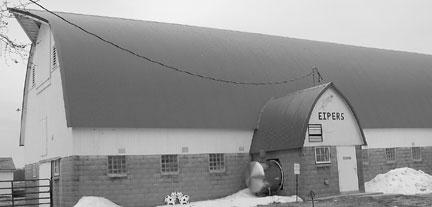
C & C STEEL ROOFING Clint 507-528-2243 Specializing in applying ribbed steel to barns, garages and outbuildings. CALL • Lowest Rates • Quality Workmanship • Insured • 6 Year Warranty • Free Estimates THE LAND — APRIL 12, 2024 www.thelandonline.com — “Where Farm and Family Meet” PAGE 15 MIELKE, from pg. 14 See MIELKE, pg. 16
KEMPEL Senior Credit offiCer Compeer finanCial MARKETING Grain prices are effective cash close on April 9. *Cash grain price change represents a two-week period.
Grain Markets corn/change* soybeans/change* Stewartville $4.13 +.12 $11.19 -.18 Edgerton $4.19 +.15 $11.18 .00 Jackson $4.18 +.13 $11.22 -.14 Hope $4.19 +.13 $11.14 -.14 Cannon Falls $4.02 +.02 $11.09 -.18 Sleepy Eye $4.05 +.09 $11.16 -.15 St. Cloud $3.99 +.04 $11.13 -.15 Madison $4.01 +.03 $10.80 -.19 Redwood Falls $4.09 +.09 $11.25 -.09
Falls $3.84 +.15 $10.85 +.02 Morris $3.98 -.02 $10.95 -.14
$4.11 +.09 $11.20 -.04
$4.07 $11.10
Ago Average: $6.33 $14.46
ELIZABETH
Cash
Fergus
Tracy
Average:
Year
Cheese exports up 27.3 percent over last year
MIELKE, from pg. 15
Dry whey saw its April 5 finish at 39 cents per pound, down 1.25 cents on the week but 2.5 cents above a year ago, with four sales on the board for the week.
The week ending March 23 saw 57,600 dairy cows go to slaughter, up 200 from the previous week, but 8,600 or 13 percent below a year ago. Year-to-date, 691,100 head have been culled, down 113,600 or 14.1 percent from a year ago.
n
U.S. dairy exports topped those of a year ago for the first time in a year, according to the USDA’s latest data. Sailings totaled 483.8 million pounds, adjusted for Leap Year, up 5.5 percent from February 2023, and set a monthly record. HighGround Dairy credited increased sales to Mexico, up 4.5 percent, and up 20 percent to Southeast Asia — though exports to China were down 24 percent.
Cheese exports totaled 95.6 million pounds, up 27.3 percent from a year ago, up for the fourth consecutive month and the largest since June 2022.
HighGround Dairy says, “Given the average Cold Storage data for February, the firm export number would suggest that domestic demand was pretty poor. This surge is primarily attributed to massive
shipments to Mexico, which totaled 36.6 million pounds and set a new monthly record.”
HighGround Dairy pointed out that cheddar exports rebounded after a year of decline and hit their highest level since January 2023.
Nonfat dry milk and skim milk powder sailings hit 148.9 million pounds, up 3.4 percent, despite reports of weak demand. Exports to Mexico were down; however, Southeast Asia saw imports jump 39 percent. Volumes also rose to Indonesia, Vietnam, Malaysia and Thailand.
Butter exports totaled just 5.1 million pounds, down 35.3 percent. HighGround Dairy says the February’s sales likely reflect bookings made as butter prices declined from their record-high levels in fall 2023. Butter imports were up 32.6 percent — the largest volume since March 2023, and the thirdhighest on record.
Whey exports were down 5.7 percent due to reduced shipments to China “where the hog sector is continuing to experience difficulties and demand for feed-grade products remains sluggish,” says HighGround Dairy. “Whey protein concentrates saw an uptick in both categories however reflecting sustained strong demand worldwide.”
n
In politics, the National Milk Producers
Federation submitted its final, formal legal “brief” on their behalf for Federal Milk Marketing Order modernization to USDA. The NMPF brief, which was submitted March 29, emphasized, “Those farmers are the reason the system exists and that, by law, their priorities are pre-eminent in USDA consideration of a final plan.”
“Our proposed package of proposals to the Federal Milk Marketing Order align thoroughly with its mission and purpose, which were intended to put farmers first,” said Gregg Doud, president and CEO of NMPF. “We’ve spent nearly three years painstakingly assembling the broad consensus among dairy farmers that modernization needs to succeed. Our approach is careful and comprehensive, and it benefits farmers of all regions and types of operations.”
Complete details are posted at www.nmpf.org/ nmpf-fmmo-modernization-comments-put-farmersfirst/.
Meanwhile the International Dairy Foods Association reports USDA is expected to soon release a final rule revising the Special Supplemental Nutrition Program for Women, Infants and Children (WIC) food package. “With it, the food and nutrition benefits of nearly 6 million mothers and children under the age of 5 are at risk of being cut,” warns the IDFA.
Lee Mielke is a syndicated columnist who resides in Everson, Wash. His weekly column is featured in newspapers across the country and he may be reached at lkmielke@juno.com.
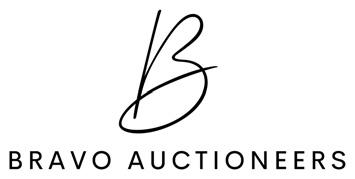








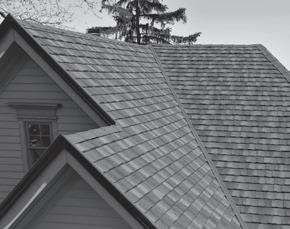








Answers located in Classified Section Make the smart and ONLY CHOICE when tackling your roof! Before After + New orders only. Does not include material costs. Cannot be combined with any other offer. Minimum purchase required. Other restrictions may apply. This is an advertisement placed on behalf of Erie Construction Mid-West, Inc (“Erie”). Offer terms and conditions may apply and the offer may not available in your area. If you call the number provided, you consent to being contacted by telephone, SMS text message, email, prerecorded messages by Erie or its affiliates and service providers using automated technologies notwithstanding if you are on a DO NOT CALL list or register. Please review our Privacy Policy and Terms of Use on homeservicescompliance.com. All rights reserved. License numbers available at eriehome.com/erie-licenses/ WI License Number: 13934. MADE IN THE U.S.A. LIMITED TIME OFFER! SAVE! UP TO 50% INSTALLATION AN ADDITIONAL 10% for military, health workers and first responders OFF OFF + 1.844.907.2386 FREE ESTIMATE Expires 4/30/2024 KANN IMPORTS COLLECTION AUCTION LIVE AUCTION WITH ONLINE BIDDING! Lalique, Lladro, Oriental, Hummel, Crystal, Sculptures, Pottery, Fine Art, Antiques, Collectibles and Much More! April 20 •10:30am at Bravo Auction Gallery, Kennedy Mall, Dubuque, IA BID ONLINE AT www.BravoAuctioneers.com PAGE 16 www.thelandonline.com — “Where Farm and Family Meet” THE LAND — APRIL 12, 2024
v
Prepare pastures for Spring grazing
Unique weather this year and limited soil moisture in many regions of the state may require a different approach to grazing this spring.
The regrowth of grasses and legumes in the spring or after grazing follows a general growth curve. Forage yield starts low because the plants’ energy stores (carbohydrates) and leaf area are small. As the leaf area increases, the plant captures sunlight to produce energy (photosynthesis), which recharges the root energy stores. Root and crown mass and tillering increases. Forage yield increases rapidly until flowering; the proportion of stems in the forage increases and flowering begins. At flowering stages, energy stores have been recharged, which can allow more rapid regrowth of plants following grazing.
In most of Minnesota, grasses and legumes typically begin flowering in late May in response to increasing length of daylight.
Above-average air temperatures and no late-winter snow cover have led to early leafy growth of pasture legumes and grasses. Spring leafy vegetative growth will be unusually long this year because grasses and legumes will likely not flower until mid-late May based on daylight. With normal spring rainfall, this should provide extra grazing time this year.
(Every year it is important to consider routine pasture management practices, such as rotational grazing, and to observe recommended pasture stocking rates to sustain and improve pasture productivity.)
Even though grass and legumes will “green-up” earlier than expected this year, resist putting animals on pasture too soon. Only start grazing when grasses and legumes have enough leaf growth (height of 6 to 8 inches) to begin replenishing carbohydrates stores used during the winter. Stop grazing when plant heights reach 3 to 4 inches. Overgrazing in the early spring will deplete energy stores, slow regrowth,
weaken plants, and reduce yields later in the season. It can also affect root and rhizome growth (underground stems) and thin stands are prone to weed invasion.
For plants stressed due to winter injury or soil heaving, longer spring growth periods will help with plant persistence.
Additionally, hoof traffic in the early spring can lead to soil compaction and be especially harmful to stand density of legumes and bunch grasses (e.g., orchardgrass, meadow fescue). Root systems of these plants may be weak or displaced by freezing or thawing cycles of the soil.
Keep the animals off pastures until the ground is firm and the grass and legumes reach sufficient heights. Ease grazing onto pastures in 15-minute, daily increments (15 minutes the first day, 30 minutes the second day, etc.) until you reach 5 hours of grazing. Acclimating animals to pasture will take several weeks. After reaching 5 hours, animals can graze continuously as long as enough grass and legumes are available. Gradual transitions in diet provide microbes in the gut time to adjust, which reduces the risk of laminitis or colic.
With early spring grazing, maintaining rest periods and observing plant height minimums before re-grazing is key. In a spring with adequate moisture and ideal temperatures, rest periods as short as 14 days are adequate for cool season grasses to reach ideal regrowth heights. During summer, rest periods of at least 30 days are common to reach the same plant regrowth heights. For alfalfa-grass mixtures, rest periods should be about 3 to 4 weeks because alfalfa (and red clover) is more prone to using up its root energy stores. For plants stressed due to winter injury or drought, longer rest periods will help with plant persistence.
This article was submitted by Krishona Martinson, PhD,University of Minnesota Extension. v
2024 Subscription Form Please complete the form below. Sign and date, include your check and put it in the mail. I own or operate 80+ acres of Minnesota and/or Northern Iowa ag cropland, raise 25+ head of livestock or am actively involved in agribusiness. Full Year Voluntary Subscription: $59 Other I do not qualify but would like a one-year subscription. Full Year Subscription: $59 Mail to: THE LAND 418 South Second Street • Mankato, MN 56001 Important – Please check all boxes that best match your farming operation. Acres 1-99 100-249 250-499 500-999 1000+ Corn Soybeans Alfalfa Wheat Sugar Beets TOTAL ACRES Livestock Head Data will NOT be sold. Hogs marketed 1-99 100-249 250-499 500-999 1000+ Sheep raised 1-99 100-249 250-499 500-999 1000+ Beef Cattle marketed 1-99 100-249 250-499 500-999 1000+ Dairy Cattle milked 1-50 51-99 100-199 200+ Name Mailing Address City, State, Zip Phone # E-mail Address Signature Date This form MUST BE signed and dated to meet postal regulations. PLEASE PRINT Return your 2024 subscription card THE LAND — APRIL 12, 2024 www.thelandonline.com — “Where Farm and Family Meet” PAGE 17 For marketing news between issues ... visit www.TheLandOnline.com

ADVERTISING NOTICE: Please check your ad the first week it runs. We make every effort to avoid errors by checking all copy, but sometimes errors are missed. Therefore, we ask that you review your ad for correctness. If you find a mistake, please call (507) 345-4523 immediately so that the error can be corrected. We regret that we cannot be responsible for more than one week’s insertion if the error is not called to our attention. We cannot be liable for an amount greater than the cost of the ad. THE LAND has the right to edit, reject or properly classify any ad. Each classified line ad is separately copyrighted to THE LAND. Reproduction without permission is strictly prohibited.

Real Estate Wanted
WANTED: Land & farms. I have clients looking for dairy, & cash grain operations, as well as bare land parcels from 40-1000 acres. Both for relocation & investments. If you have even thought about selling contact: Paul Krueger, Farm & Land Specialist, Edina Realty, 138 Main St. W., New Prague, MN 55372. paulkrueger@edinarealty.com (612)328-4506
Feed Seed Hay
Alfalfa, mixed hay grass hay & wheat straw. Medium squares or round bales. Delivery available. Call or text LeRoy Ose 218-689-6675
OPEN Pollinated Seed Corn. Produces more high quality silage on less acres than hybrid. $67/bushel plus shipping. High feed value grain. borriesopenpollinatedseedcorn.com 217-857-3377 or 217-343-4962
Fertilizer & Chemical
Gen Liberty totes, $17.5 0; Glyphosate 5.4 totes, $13.95; Enlist 1 totes, $46.95; Gen Surestart $4 5. 35; Atrazine totes, $15.75. All tote prices include free delivery to most areas. Please call or text for any other chemical needs. Phone 612-210- 3685
Bins & Buildings SILO
TRACTORS
NEW NH T4.75, T4.90, T4.120 w/loader .... Coming
NEW NH Workmaster 60, 50, 35’s/loaders ....Coming
NEW NH 25S Workmasters ...….......…. On Hand
NEW Massey 2850M & 2860M ............. On Hand
NEW Massey 4710 & 4707 ….............. On Hand
New Massey GC1725M …….................. On Hand
’16 Massey 4608 rops w/loader …............. $36,900
’21 NH T7.260 ……….............………… $164,000
’18 NH T4.75 w/loader .............................. $49,900
’16 NH T8.380 w/2000 hrs ....................... $194,000
’12 NH T9.560 2200hrs ……..........…… $235,000
’12 NH T9.560 800 metric …….……… $229,000
IH 666 nice …….................................……. $8,900
Oliver 1850 w/loader ………………….….. $9,250
’14 Versatile 375T4 PS ………………… $179,500
’07 CIH Magnum 215 ……….………… $124,000
Ford 7700 w/loader ……………......……. $12,500
TILLAGE
Sunflower 4412-07 ……...........…………. $29,500
’21 Wil-rich 2530 37’ Chisel ….....………. $67,000
’21 Kuhn 8010-25 ……............……....….. $79,500
CONSTRUCTION EQUIPMENT
NEW NH L318/L320/L328 wheeled units .. On Hand
NEW NH C327/C337/C345 track units .. On Hand
’18 NH L234 425hrs ………........…….. $53,000
’19 NH L228 725hrs …..................…….. $42,000
HAY TOOLS
New Disc Mowers - 107,108,109 ............ On Hand
New Disc Mower Cond. - 10’, 13’ ........... On Hand
New Wheel Rakes - 10,12,14 .................. On Hand
Kuhn SR112 Rake ……................................ $6,900
NH H6740 disc mower ……….................... $8,500
NH 488 ................................................... On Hand
’13 NH H7230 ………..................………. $22,500
’15 NH H7230 ......................................... On Hand
PLANTERS
NEW White 9936VE .................................... On Hand
NEW White 9924VE ..................................... On Hand
NEW Massey 9816VE .................................. On Hand
NEW Massey 9812VE .................................. On Hand
NEW Massey 9222VE .................................. On Hand
JD 7200 12-30 w/LF ……….........................…… $15,500
White 6186 16-30 w/ins …….............……….. $12,500
Taking 2024 New Spring Orders
COMBINES
NEW Gleaner S97 Coming
NEW Gleaner S96 Coming
’18 Gleaner S97 ............................................ $339,000
’15 Gleaner S78 loaded …….….........…...... $225,000
’07 Gleaner R65 ……..............................…….. $71,500
Geringhoff parts & heads available
MISCELLANEOUS
NEW Salford RTS Units ........................................ Call NEW Unverferth Seed Tenders .............................. Call NEW Westfield Augers .......................................... Call NEW REM VRX Vacs. .......................................... Call NEW Hardi Sprayers ............................................. Call
NEW Riteway Rollers ............................................ Call
NEW Lorenz Snowblowers .................................... Call NEW Batco Conveyors .......................................... Call NEW Brent Wagons & Grain Carts ....................... Call NEW E-Z Trail Seed Wagons ................................ Call NEW Rock Buckets & Pallet Forks ....................... Call New Horsch Jokers ................................................. Call
WANTED TO BUY: LAND 507-339-1272
Check out THE LAND online www.thelandonline.com
Classified line ads work! Call 507-345-4523
Take-down & clean up
Specializing in silos in congested areas.
FULLY INSURED mobile concrete crushing. 507-236-9446
Stormor Bins & EZ-Drys.
100% financing w/no liens or red tape, call Steve at Fairfax Ag for an appointment.
888-830-7757
Cleaning out a shed?
Make some extra cash by selling your stuff in The Land!
Call 507-345-4523 or 1-800-657-4665
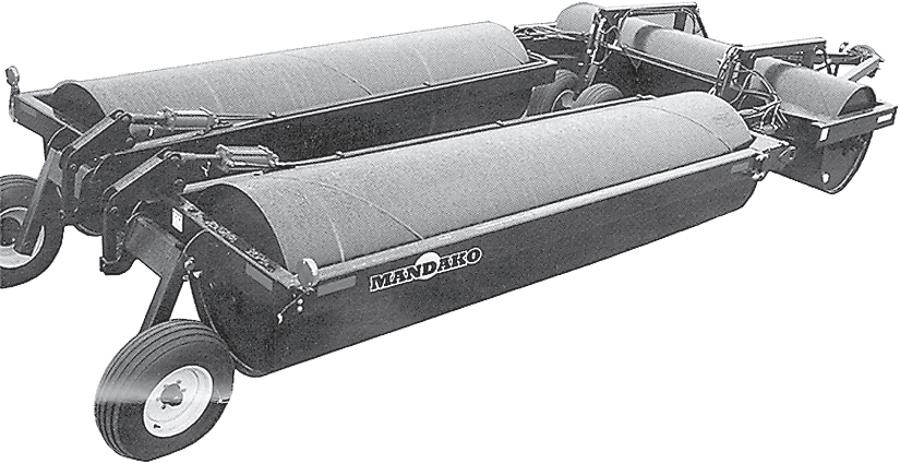



PAGE 18 www.thelandonline.com —”Where Farm and Family Meet” THE LAND — APRIL 12, 2024
(507) 234-5191 (507) 625-8649 Hwy. 14, 3 miles West of Janesville, MN Mon.-Fri. 7:30-5:00 • Sat. 7:30-Noon THANK YOU FOR YOUR BUSINESS! GREENWALD FARM CENTER Greenwald, MN • 320-987-3177 14 miles So. of Sauk Centre FOR THE BEST DEAL ORDER NOW! 12’-60’ LONG ROLLERS MANDAKO • 5/8” drum roller wall thickness • 42” drum diameter wall thickness • 4”x8” frame tubing 3/8” thick • Auto fold SATURDAY, APRIL 27 • 9:30 A.M. LOCATION: 19620 368th St., Forest City, IA OWNER: LYNN LOVIK Birmingham 12" × 36" turning lathe, milling & drilling machine, Miller 250 wirefeed welder, 5hp. air compressor/80 gal. tank, many saw sharpening machines, O/A torch w/tanks, many more larger equipment pieces used for saw sharpening, plus a wide variety of hand tools. For complete details & photos visit www.hawkeyeauction.com BRUCE HELGESON • 641-592-2754 SAW SHARPENING EQUIPMENT & REPAIR SHOP RETIREMENT AUCTION
FOR SALE: JD 6x4 dsl Gator, has a bed hoist, bedliner, turn signals. Grain bins: 1-18’ 2-21’, 2-24’, 1-30’. All bins have full aeration floors, 2 have sweep augers. All in good shape, no rust. Selling for 30 cents/bu. Small square grass bales stored inside, easy loading.
320-587-9409
FOR SALE: Unverferth seed tender, w/ scale, talc applicator, 3 axles, 17’ conveyor, $28,500; JD 4000, WF, dsl tractor, $14,500; JD 16R cult, w/ rolling shields, $5,000; Batco 15x35 belt conveyor, used for seed beans, $8,000.
507-370-4416
FOR SALE: 16 Yetter trash whippers off JD 1770, $100/ ea OBO. 507-920-7954 FOR SALE: Seed tender 2 compartment gravity wagon w/ tarp, brush auger & telescoping tube, $3,250/OBO. 507-920-7954
FOR SALE: JD 7000 4RN planter, monitor with new tires; JD 443 low tin cornhead, SN471-802, both in good condition. 320-732-6280 or 320-760-5228 (c)
FOR SALE: Int’l 16R 183 culitvator. Also, 30’ folding toolbar w/ rear assist. Also, 40’ tool bar w/ folding wings. 507-370-7268
FOR SALE: 3710 John Deere 9 bottom plow, hasn’t plowed 2000 acres, asking $25,000. 507-391-5127
FOR SALE: JD 1760 12R30” front fold liquid fertilizer planter; JD 235 disk, 21’, hyd folding wings. 952-466-5649
We buy Salvage Equipment Parts Available Hammell Equip., Inc. (507)867-4910
Tractors

‘95 JD 8200 2WD with 18.4R46 rear tires and duals (70%), 7757 hours, front weights, 1000 PTO, 3 hyd. Remotes, quick hitch. Very nice one owner tractor. Asking $49,900. 507-789-6049
Tractors
FOR SALE: 1966 JD 4020 diesel, syncro transmission, 2 rear remote hydraulics, very good condition. 651-258-4057
FOR SALE: 8230T JD Track Tractor (2007) 5298 hrs, auto trac ready, $87,000. 507-327-6430
NEW AND USED TRACTOR
PARTS JD 10, 20, 30, 40, 50, 55, 50 Series & newer tractors, AC-all models, Large Inventory, We ship! Mark Heitman Tractor Salvage 715-673-4829
“Where
Farm and Family Meet” THE LAND...since 1976
Planting Equip
FOR SALE: JD 1750 Conservation 6R corn planter with corn and bean meters, computer Track 200 monitor, lots of new parts, $14,000. 320-250-7552
FOR SALE: Kinze 3600 planter, 16/31, KPM2 monitor, liquid fertilizer, air clutcher, mechanical or hydraulic drive, $22,000. Marietta MN, 320-226-3837
FOR SALE: Retiring. JD 7200 12R30 planter, vacuum, Liq fert, dawn row cleaners, JD monitor, good cond, $12,500. 651-503-5087
Sp ring Co nsign ment Auction
Saturday, April 27th - 9:30 am
55780 St Hwy 19, Winthrop, MN
Ring 1 - Live & Online Simulcast - Machinery, Vehicles & Guns
Saturday, April 27th - 9:30 am

Tractors, Farm Machinery & Equipment: 2016 Hagie sprayer w/ 90’ boom, 1 owner; Century 1300 gal sprayer, 90’; NH 8970 tractor, 3920 hrs, FWA; Farmall C tractor; RC Case tractor; Farmall H tractor; 1990 Timpte semi trailer; 1988 Kiefer livestock trailer, 16’; 2010 JD 1760NT planter, 8x30”, w/ computer track 350 monitor; JD 7000 planter, 8x38”, w/ Dickey John monitor; IH grain drill, 14’x6”; IH grain drill, 12’; JD drill grass attcht, 10’; JD tandem disk w/ spring folding wings, 20’; Case IH 501 disk, 14’; IH 370 disk, 12’; JD 1600 chisel plow, 12 shank,; JD 100 chisel plow, 12’; H&S V12 hay rake; JD 896A side rake; H&S tandem manure spreader; JD 370 manure spreader; Fetrel auger, 10”x66’, pto; bale elevator w/ elect motor, 28’; JD 843 corn head; Unverferth seed auger truck mount; Leinbach line post hole digger, 3 point, 9” bit; Calumet 2250 vaxuum tank spreader w/ injectors; large pump, tandem axle, 6” hose; 6 ton bulk bin; H&S bale throw rack w/JD running; Mokee snowblower, 7’, dbl auger; King cutter finishing mower, 6’, 3pt; Ag Systems 1000 gal tank on tandem trailer, no pump; JD 15k pto driven generator; IH center mounted planter, 2 row; assort. of skid steer attachments; Campers, Boats, & Lifts; 2021 Gulf Stream camper trailer, mod 275 FBG;2023 Forrest River Wolfpup camper trailer, mod BHS 16; 2008 Fleetwood Evolution pop up camper trailer, mod E3; 2017 Pontoon Crest I, 22’, 115 Mercury outboard motor, tri-toon, no trailer; alum; 1982 Lund fishing boat w/ 1983 Range trailer, 16’; Hewitt 1501 alum boat lift, 3600 lb; 2 section riveted 2 seat boat; Sears duck boat, 12’; Vehicles, & Trailers: 2009 Pontiac G8 GT 6.0 V8; 2006 Dodge Ram 3500, 245,000 miles, aux diesel, manual trans, quad cab, 4x4, 5th wheel, dual; 2002 Dodge Ram van, 77, 646 miles; enclosed trailer, H - 6’ L - 12.5’ W - 7’; 2 wheel pickup box trailer; Lawn Mowers, & Misc: White lawn mower, 52”; MN #3 horse mower, 5’; Aermotor tower windmill, 35’; Challenger tower windmill, 40’; 2 - windmill heads; single horse drawn buggy; single horse sleight; barge box on running, hyd hoist; wagon; bobcat bucket, 4’; cow cupola; pig cupola; barn doors; weather proof deck, unknown size; Guns: Over 100 guns including commemorative 24k gold plated revolvers, rifles, and dbl barrel shotguns engraved by A&A Engraving Inc. of Rapid city SD, a large assort of long guns like Winchester , Remington, Ruger, Ducks Unlimited, & Savage Arms, various hand guns including guns from Ruger, Taurus, Colt, 7 other brands and models!
Ring 2 - Online-Only - All Other Items
First Lots Start Closing: Saturday, April 27th - 3:00 pm
Payment & Pick-up: Monday, April 29th - 9 am to 5 pm see magesland.com for complete terms, & details.

Yard, Shop & Tools: Darra James table saw w/ Leland 1/3 hp motor, mod 245-B; Craftsman 12’ bandsaw sander, mod 113.243310; Craftsman 6” jointer/planer, mod 133.206931; General Machinery 10” auto planer, mod 5-6935; Craftsman 12” wood lathe on tool chest, mod 113.228160; Craftsman 10” radial saw, mod 113.19771; Craftsman table saw on cart; Snap-on 2000 psi electric power washer, mod 692024;JD BH30 leaf blower; Husqvarna weed whip; Jepson saw, 10”; Walk behind weed trimmer, gas; transfer pump, gas, 2” connections; 4 - pillow block bearings, 2”; 50’ settling hose; cat 1 blade, 6’; 18” rod; small air compressor; Tactacam reveal camera; Appliances, Furniture & Misc: Paulson wood stove; multiple pieces of furniture including desks, tables, dressers, chairs, and side tables; 2 wheels & seat from dump rig; cardinal lamp, Timex anniversary clock; 2 - Icehouse beer light bottles; Antiquities: Multiple cookie jars; glass blue swans; barley twisted wash basin; metal foldable candy dish; Walmart associate dolls; Farmers Co -op rain gauge; JD vintage Reindeer plush toy Johnny Deerest RARE Rudolphs; Memorabilia Multiple unopened baseball card boxes from Upper Deck, Score, The Leaf, Fleer, & Minor League. As well as other memorabilia items such as1991 World Series Wheaties Box, Kirby Puckett Collectors edition Wheaties Box; Kirby Pucket porcelain cards, Dale Jarret Kirby Pucket bobble head; Daunte Culper bobble head; Collectables: Large asst of steins w/ original boxes from Leinenkugel, Schmidt, ; Miller Holiday, Regal Corn stalk mugs; Big Gain 1990 Roy Clark Show Mugs; Hermann the German & Thusnelda bobble head; Hot Wheel cars. Multiple die cast toy tractors; farm equipment, cars & trucks including JD, MM, Tonka, & ERTL; Coins: Large collection of coins including full uncirculated coin sets, foreign currency, multiple different mints, and much more!
Hundreds of items also included at magesland.com
THE LAND — APRIL 12, 2024 www.thelandonline.com — “Where Farm and Family Meet” PAGE 19
Upcoming Farmland Auctions April 17, 2024 • 58.29 ± Acres Farmland Douglas Twp, Dakota Co, MN
•
Litchfield
April 23, 2024
228 ± Acres Farmland
Twp, Meeker Co, MN
507-345-LAND (5263) WWW.HERTZ.AG 151 St. Andrews Court #1310, Mankato MN 56001 FA R M L A N D F O R S A L E WANTED CALL FOR A QUOTE TODAY 1-800-828-6642
PRUESS ELEV.,
April 25, 2024 • 135.37 ± Acres Farmland Boon Lake Twp, Renville Co, MN Farmland For Sale 80.10 ± Acres Farmland Swedes Forest Twp, Redwood Co, MN 16.60 ± Acres Farmland and Building Site South Bend Twp, Blue Earth Co, MN For property brochures, contact Hertz at
We pay top dollar for your damaged grain. We are experienced handlers of your wet, dry, burnt and mixed grains. Trucks and vacs available. Immediate response anywhere. DAMAGED GRAIN STATEWIDE
INC.
Neighbors Listing Auctioneer: Matt Mages, 507 -276-7002 Lic: 52-24-018 Broker/Clerk: Mages Land Co & Auction Service, LLC Terms: 10% Buyer’s Premium. 15% Buyer’s Premium on Online items. Everything sold “AS IS”. Tax, license & registration fees may apply on some items. All firearms transferred according to law. Not responsible for accidents. Lunch & restroom on grounds. magesland.com -
Equipment
Area
Farm
To submit your classified ad use one of the following options:
Phone: 507-345-4523 or 1-800-657-4665
Mail to: The Land Classifieds, 418 South Second Street, Mankato, MN 56001
Fax to: 507-345-1027 • Email: theland@TheLandOnline.com
Online at: www.thelandonline.com
DEADLINE: 7 days prior to publication. Plus! Look for your classified ad in the e-edition.
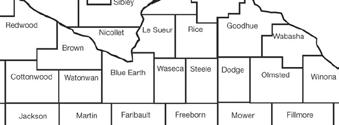

Recreational Vehicles
Miscellaneous
NOTE: Ad will be placed in the appropriate category if not marked.
PAGE 20 www.thelandonline.com —”Where Farm and Family Meet” THE LAND — APRIL 12, 2024 Name Address City State_________ Zip__________ Phone # of times _______ Card # Exp. Date__________________ Signature CHECK ONE: Announcements Employment Real Estate Real Estate Wanted Farm Rentals Auctions Agri Business Farm Services Sales & Services Merchandise Antiques & Collectibles Lawn & Garden Feed Seed Hay Fertilizer & Chemicals Bins & Buildings Farm Equipment Tractors Tillage Equipment Planting Equipment Spraying Equipment Hay & Forage Equipment Harvesting Equipment Grain Handling Equipment Livestock Equipment Wanted Free & Give Away Livestock Poultry Dairy Cattle Swine Sheep Goats Horses & Tack Exotic Animals Pets & Supplies Cars & Pickups Industrial & Construction Trucks & Trailers
CHECK
ADVERTISING NOTICE: Please check your ad the first week it runs. We make every effort to avoid errors by checking all copy, but sometimes errors are missed. Therefore, we ask that you review your ad for correctness. If you find a mistake, please call (507) 345-4523 immediately so
error
insertion
error
to our attention.
cannot be liable for an amount greater than the cost of the ad. THE LAND has the right to edit, reject or properly classify any ad. Each classified line ad is separately copyrighted to THE LAND. Reproduction without permission is strictly prohibited. THE FREE PRESS South Central Minnesota’s Daily News Source
Land!
Reach
readers • Start your ad in The Land • Add more insertions • Get more coverage Your First Choice for Classifieds! Place Your Today!Ad Now... add a photo to your classified line ad for only $10.00!! SORRY! We do not issue refunds. 1 2 3 4 5 6 7 8 9 10 11 12 13 14 15 16 17 18 19 20 21 22 23 24 25 26 27 28 29 30 31 32 33 34 35 36 * The ad prices listed are based on a basic classified line ad of 25 words or less. Ads running longer than 25 words will incur an added charge. * 1 edition @ $21.99 = 2 editions @ $38.99 = 3 editions @ $48.99 = Each additional line (over 7) + $1.40 per line per issue = EXTENDED COVERAGE must run the same number of times as The Land PAPER(S) ADDED FN CT FP (circle all options you want): $7.70 X _____ each edition X _____ publications = STANDOUT OPTIONS (THE LAND only) $2.00 per run: = * Photo Border (The Land only) $10.00 each, per edition. = TOTAL = This is NOT for businesses. Please call The Land to place line ads. EXTENDED COVERAGEFARM NEWS (FN) - Serving farmers in Northwest Iowa, 8,400 circ. THE COUNTRY TODAY (CT)Serving farmers in Wisconsin, 7,902 circ. THE FREE PRESS (FP)Serving south central Minnesota, 11,157 circ. STANDOUT OPTIONS Bold Italic Underline Web/E-mail links
that the
can be corrected. We regret that we cannot be responsible for more than one week’s
if the
is not called
We
Livestock, Machinery, Farmland... you name it! People will buy it when they see it in The
•
over 150,000
PLANNING AN AUCTION?
Get the best results when you advertise in THE LAND
507-345-4523



Sell your farm equipment in The Land with a line ad. 507-345-4523






Hertz Farm Management of Mankato, MN is proud to announce that farmland professionals Nick Meixell, Darrell Hylen, ALC, and Jared Augustine have been recognized as part of the 2023 APEX Producers Club by the REALTORS® Land Institute. Darrell Hylen was also recognized as a 2023 Regional Broker of the Year.
Congratulations to Nick, Darrell, and Jared!
Farmland Real Estate | Farm Management | Appraisals ,
Hertz Farm Management, Inc. 151 St. Andrews Ct. #1310 Mankato MN 507-345-LAND (5263) | www.Hertz.ag

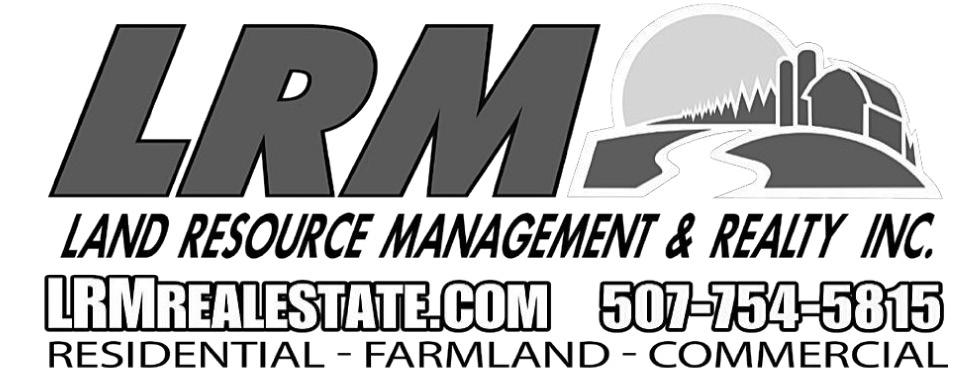




GREATER MINNESOTA TWO-CYLINDER CLUB
32nd Annual FIELD DAYS AND SWAP MEET
May 3 & 4, 2024
Morrison County Fairgrounds Little Falls, MN
Daily Events:
Tractor, Equipment, Gas Engine and Snowmobile Displays, Swap Meet, Silent Auction, Kids Activities
Friday Events: Displays, Swap Meet and Tractor Pull 6 pm
Saturday Events:
Displays, Swap Meet, Garden Tractor Pull at 10 am, Pedal Tractor Pull at 1 pm, Antique Tractor Pull at 12:30 pm
Show Featuring:
John Deere models with multiple letters, all other brand models with both letters and numbers. All brands of garden tractors. Scorpion and Brut snowmobiles.
All Tractor, Gas Engine, & Snowmobile Exhibitors, and Vendors Welcome Info: 320.733.0111, www.gmntcc.com




JD 6620 Side Hill & White 8900 Combine
JD 6620 Side Hill, Hydro, Chopper, 5230 Hrs, Side Hill Works; White 8900 Dsl, Hydro, 4933 Hrs;
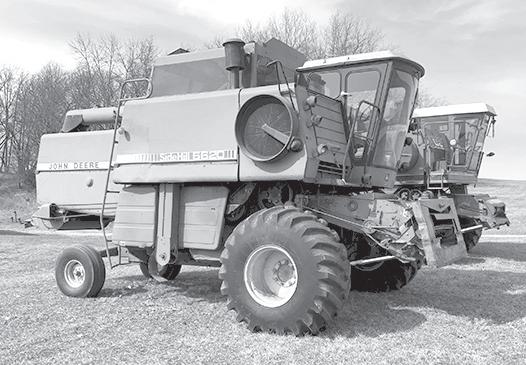

Oliver Farm Tractors
(3) Oliver 1850 Dsl Tractors, 7453, 4660, & 7106 Hrs, 18.4-38, 3pt, 2 Hyd., PTO;
(2) Oliver 550 Low Profile, 4142 & 1996 Hrs, 3pt, Weights, Fenders; Oliver 880, Gas, Row Crop, 15.5-38, Fenders; Oliver 88 Dsl, WF, Fenders, PS, w/Paulson Loader; Oliver 88 Gas, Row Crop,15.5-38, Fenders; Oliver 77 Gas, Row Crop, NF, Weights, Fenders; Oliver 80 Row Crop, Older Restoration, 32.6-38, Unstyled, Fenders; Oliver 70 Gas, NF, Flat Spokes, Fenders; Case VAC, NF, 12.4-28, Pully; Steiger Bear Cat 4WD, 6665 Hrs, 3208 Cat, 3pt, 28L-26, 10’Belly Blade
Planter-Drills-Tillage Machinery
(2) JD 7000 Planters, 6R30” Dry Fert., Insect; (2) IHC 5100 Double Drill, Squadron Hitch, 12’x6” Spacing; Melroe 242 Grain Drill 12’x6”; IHC 490 Disk, 23’ ; White 271 Disk, 24’, Rock
Oliver Plows, 4x18’s, 4x16’s, 3x16’s; Lindsay 15’ Drag on Cart; IHC 470 Disk 22’ Hydraulic Lift; JD CCA 12’ Digger; Duall 20’ 3pt Application Bar; JD RWA 14’ Disk; Glenco 17.5’ Field Digger





THE LAND — APRIL 12, 2024 www.thelandonline.com — “Where Farm and Family Meet” PAGE 21 WWW.HMAUCTION.COM WWW.HMAUCTION.COM MARING AUCTION, LLC. PO Box 37, Kenyon, MN 55946 507-789-5421 • 800-801-4502 Matt Maring Lic# 25-28 Kevin Maring Lic# 25-70 Adam Engen Lic# 25-93 HAMILTON AUCTION CO. 130 State Highway 16 Dexter, MN 55926 • 507-584-0133 Andrew Hamilton Lic# 50-128 Cell: 507-438-6693 Bill Hilton • 507-279-9600 FOR COMPLETE DETAILS & BIDDING GO TO: PAYMENT & PICKUP DATES: Wednesday, April 24 from 9:00 a.m. - 4:30 p.m. (Loading Assistance on April 24 Only) INSPECTION: Terms: Cash, check, all major credit card. All sales final, all sales are selling as-is, all items must be paid for in full, 10% buyers premium with cap of $1000. Tuesday, April 23, 2024 • 10:00 a.m. HM AUCTION GROUP PRESENTS ONLINE ONLY FARM ESTATE AUCTION Auction Location: 635 82nd Street N.E. Rochester, MN 55906 (Take N. Broadway Ave. North to Hwy 63, West on 63 to 20th Ave. N.E., Follow 20th Ave. N.E. to 82nd Street N.E.) Bidding Opens: Monday April 15, 2024 at 8:00 a.m. BIDDING STARTS CLOSING: Oliver 2255 2WD Oliver 2255 Dsl, 3160 Cat, 8023 hrs, 18.4-38 w/Duals, Cab, 3pt, 2 Hyd, PTO,
SN# 237-372-705
Flex; White 484 30’ FC, 3 Bar Harrow; Landall 9 Shank Disc Chisel, Buster Bar; Bush Hog 7 Shank Disc Chisel; JD 550 Crop Sprayer, 30’ Booms; Brady 15’ Stalk Chopper, 1000 PTO; (3)
JD 643 Corn Head; JD 216 Bean Head; White 704W 6 Row Corn Head Haying & Other Farm Equipment, Grain Dryer-Holding Bin IHC 241 Round Baler; 2017 Bobcat Model SB200, 66” Snowblower; JD 503 3pt Rotary Mower; (6) 175-250 Bushel Gravity Boxes w/ Gears; Behlen HA 260 Auto Batch Crop Dryer, Single Phrase, LP Gas, 2200 Hrs; 1500 Buchel Holding Bin; Gehl 32MX Mixer Mill; SpeedCo 6’ 3pt Rear Blade; IH 990 Haybine 9’, 540 PTO; MN 110 Manure Spreader; ‘06 Honda Rancher ATV, 400 ; ’82 Honda 200 3-Wheeler; ’78 Ford F250 4x4, V8, Auto; Western 7.5 Power Angle Snowplow; 14’ Bumper Hitch Livestock Trailer; GMC 2 Ton Truck V6, 5x2 Speed, w/13’ Box & Hoist; Log Chain; Anvil; Jack Stand; Tools; Welder HMAUCTION.COOM ONGROUPPRESENT S J 5 D H Darrell Schultz Estate Congratulations! REALTORS®
Land Institute’s 2023 APEX Producers Club
Darrell
Hylen ALC
Jared Augustine
Nick Meixell
Have an upcoming auction? Talk to your auctioneer or call our friendly staff at 507-345-4523 or 800-657-4665 to place your auction in The Land. theland@thelandonline.com or www.thelandonline.com
•
• randy@Irmrealestate.com Ryan Queensland • 507-273-3000 • ryan@Irmrealstate.com Grand Meadow, MN • 800-658-2340 Full Farm Management Services Ensure Asset Preservation, Conservation, Negotiate Leases and Terms to Fit Ever Changing Industry Trends. Call Randy or Ryan today for more details! Find out what your farmland is worth.
COUNTY:
MLS
listings! We have qualified
SALE:
Spraying
Randy Queensland
507-273-3890
FILLMORE
Approx 147 acres, some tile, 92.4 CPI.
#6502688 MOWER COUNTY: Approx 240 acres, tile, 84.2 CPI. MLS# 6455129 “Need
buyers!” Planting Equip FOR
24’ Great Plains front fold grain drill, w/ markers and extra press wheels, $16,500. 952-201-1176
Equip FOR SALE: Fast 9420, 90’ boom, 1,250 gal tank, triple nozzle bodies, 450 Raven rate controller, hyd boom height control, always shedded. Call Doug 507-642-8564 PM hours

Wanted
All kinds of New & Used farm equipment - disc chisels, field cults, planters, soil finishers, cornheads, feed mills, discs, balers, haybines, etc. 507438-9782
WANTED TO BUY: International 1456 tractor in good condition. 507-429-8990
Please recycle this magazine.
Wanted
WANTED: Older 4X4 tractor IH, Steiger or Versatile; Various sized IH disk, 21’ or other sizes, w/ hydro wings, 7000 or 7100 planter, JD First 9000 Series & 6620 or 7720 combine. 320-760-6050
Looking for something special?
Put a line ad in The Land and find it!
Call The Land today! 507-345-4523
Answers for Tossed Salad Word Search
Livestock
FOR SALE: Black Angus bulls also Hamp, York, & Hamp/ Duroc boars & gilts. Alfred (Mike) Kemen 320-598-3790
Sell
Cattle
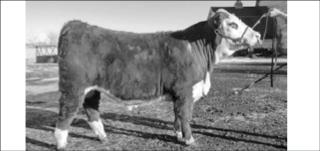
FOR SALE: Registered Polled Hereford yearling bulls for sale. Have had all shots, poured and semen tested. Halter broke. Fantastic growth E.P.Ds. Will deliver. Klages Herefords. Ortonville MN. 320-273-2163 (H) 605-880-0521(C)

Swine
FOR SALE: Yorkshire, Hampshire, Duroc, cross bred boars, and gilts. Top quality. Excellent herd health. No PRSS. Delivery available. 320-760-0365
Spot, Duroc, Chester White, Boars & Gilts available.
Monthly PRRS and PEDV. Delivery available. Steve Resler. 507-456-7746
Trucks & Trailers
FOR SALE: FORD power stroke 7.3 dsl engines, transmissions and parts, very low mileage w/ warranty, will install. 320-583-0881
Miscellaneous
PARMA DRAINAGE PUMPS
New pumps & parts on hand. Call Minnesota’s largest distributor
HJ Olson & Company 320-974-8990 Cell - 320-212-5336


PAGE 22 www.thelandonline.com —”Where Farm and Family Meet” THE LAND — APRIL 12, 2024
• www.thelandonline.com
Where farmers buy, sell and trade. 507-345-4523
THE LAND!
be here!
Thank you for reading
Your ad could
507-345-4523
your livestock in The Land with a line ad. 507-345-4523


CASH FOR CARS! We buy all cars! Junk, high-end, totaled – it doesn’t matter! Get free towing and same day cash! NEWER MODELS too! Call 1-877-978-2510. (mcn)
GOT AN UNWANTED CAR???
DONATE IT TO PATRIOTIC HEARTS.
Fast free pick up. All 50 States. Patriotic Hearts’ programs help veterans find work or start their own business. Call 24/7: 1-844-588-6535. (mcn)
Get your deduction ahead of the yearend! Donate your car, truck, or SUV to assist the blind and visually impaired. Arrange a swift, no-cost vehicle pickup and secure a generous year-end tax credit. Call Heritage for the Blind Today at 1-855-977-7030 today! (mcn)
Donate your car, truck, boat, RV and more to support our veterans! Schedule a FAST, FREE vehicle pickup and receive a top tax deduction! Call Veteran Car Donations at 1-888-429-2331 today! (mcn)
AFFORDABLE TV & INTERNET. If you are overpaying for your service, call now for a free quote and see how much you can save! 1-866-472-7954. (mcn)
DIRECTV Sports Pack. 3 Months on Us! Watch pro and college sports LIVE. Plus over 40 regional and specialty networks included. NFL, College Football, MLB, NBA, NHL, Golf and more. Some restrictions apply. Call DIRECTV 1-866-296-1409. (mcn)
Get DISH Satellite TV + Internet! Free Install, Free HD-DVR Upgrade, 80,000 On-Demand Movies, Plus Limited Time Up To $600 In Gift Cards. Call Today! 1-855-434-0020 (mcn)
HI-SPEED INTERNET, ANYWHERE! Shop With A Viasat Expert For High Speed Satellite Internet. New Customer Deals In Your Area. Nationwide Service. CALL NOW 1-877449-1844. (mcn)
Get Boost Infinite! Unlimited Talk, Text and Data For Just $25/mo! The Power Of 3 5G Networks, One Low Price! Call Today and Get The Latest iPhone Every Year On Us! 877-683-5440. (mcn)
The COVID crisis has cost us all something. Many have lost jobs and financial security. Have $10K In Debt? Credit Cards. Medical Bills. Car Loans. Call NATIONAL DEBT RELIEF! We can help! Get a FREE debt relief quote: Call 1-866-552-0649. (mcn)
DENTAL INSURANCE from Physicians Mutual Insurance Company. Coverage for 400 plus procedures. Real dental insurance -NOT just a discount plan. Do not wait! Call now! Get your FREE Dental Information Kit with all the details! 1-855-973-9175 www. dental50plus.com/midwest #6258. (mcn)
DIAGNOSED WITH LUNG CANCER and 65+? You may qualify for a substantial cash award. NO obligation! We’ve recovered millions. Let us help!! Call 24/7, 1-866-533-1701. (mcn)
ATTENTION OXYGEN THERAPY USERS! Discover Oxygen Therapy That Moves with You with Inogen Portable Oxygen Concentrators. FREE information kit. Call 1-888-815-4903. (mcn)
Portable Oxygen Concentrator May Be Covered by Medicare! Reclaim independence and mobility with the compact design and long-lasting battery of Inogen One. Free information kit! Call 844-716-2411. (mcn)
Don’t let the stairs limit your mobility! Discover the ideal solution for anyone who struggles on the stairs, is concerned about a fall or wants to regain access to their entire home. Call AmeriGlide today! 1-877-916-2093. (mcn)
STOP OVERPAYING FOR HEALTH
INSURANCE! A recent study shows that a majority of people struggle to pay for health coverage. Let us show you how much you can save. Call Now for a no-obligation quote: 1-888-772-8454. You will need to have your zip code to connect to the right provider. (mcn)
Don’t Pay For Covered Home Repairs Again! Our home warranty covers ALL MAJOR SYSTEMS AND APPLIANCES. We stand by our service and if we can’t fix it, we’ll replace it! Pick the plan that fits your budget! Call: 1-877-743-7971(mcn)
AGING ROOF? NEW HOMEOWNER?
STORM DAMAGE? You need a local expert provider that proudly stands behind their work. Fast, free estimate. Financing available. Call 1-888-7708025. Have zip code of property ready when calling! (mcn)
WATER DAMAGE CLEANUP: A small amount of water can lead to major damage to your home. Our trusted professionals dry out the wet area and do repairs to protect your family and your home’s value! If you have water in your home that needs to be dried, call 24/7: 1-888-750-5574. Have zip code of service location ready when you call! (mcn)
These Might be the Bible Answers you’ve been Looking for! www. MusingsAboutGod.com Logical, Clear, Respectful... ahhhh...but a little Different. Please Remember this Website Address! Doubtful you’ll see this AD again. (mcn)
LONG DISTANCE MOVING: Call today for a FREE QUOTE from America’s Most Trusted Interstate Movers. Let us take the stress out of moving! Speak to a Relocation Specialist, call 1-855-315-1216. (mcn)
NEED NEW FLOORING? Call today schedule a FREE in-home estimate on Carpeting & Flooring. Call Today! 1-844-588-6590. (mcn)
BATH & SHOWER UPDATES in as little as ONE DAY! Affordable prices - No payments for 18 months! Lifetime warranty & professional installs. Senior & Military Discounts available. Call: 1-855-315-1330. (mcn)
Replace your roof with the best looking and longest lasting material steel from Erie Metal Roofs! Three styles and multiple colors available. Guaranteed to last a lifetime! Limited Time Offer up to 50% off installation + Additional 10% off install (for military, health workers & 1st responders.) Call Erie Metal Roofs: 1-844-907-2386. (mcn)
Prepare for power outages today with a Generac Home Standby Generator. Act now to receive a FREE 7-Year warranty with qualifying purchase. Call 1-877228-5789 today to schedule a free quote. It’s not just a generator. It’s a power move. (mcn)
Eliminate gutter cleaning forever! LeafFilter, the most advanced debrisblocking gutter protection. Schedule a FREE LeafFilter estimate today. 20% off Entire Purchase. Plus 10% Senior & Military Discounts. Call 1-855-5771268. (mcn)
(mcn)
Safe Step. North Americas #1 Walk-In Tub. Comprehensive lifetime warranty. Top-of-the-line installation and service. Now featuring our FREE shower package and $1600 Off for a limited time! Call today! Financing available. Call Safe Step 1-844-290-5083. (mcn)
Switch and save up to $250/year on your talk, text and data. No contract and no hidden fees. Unlimited talk and text with flexible data plans. Premium nationwide coverage. 100% U.S. based customer service. For more information, call 1-888-909-7338. (mcn)
The bathroom of your dreams in as little as 1 day. Limited Time Offer - $1000 off or No Payments and No Interest for 18 months for customers who qualify. BCI Bath & Shower. Many options available. Quality materials & professional installation. Senior & Military Discounts Available. Call Today! 1-833-618-1178. (mcn)
Treat yourself to life hacks worth knowing! Freebies worth getting! For your family, your business, your future? Subscribe to Sanko’s World. Free, Fun, helpful, unique. Mooncows.com. (mcn)
INJURED IN AN ACCIDENT?
Don’t
Accept the insurance company’s first offer. Many injured parties are entitled to cash settlements in the $1000’s. Get a free evaluation to see what your case is really worth. 100% Free Evaluation. Call Now: 1-888-767-0798(mcn)
YOU MAY QUALIFY for disability benefits if you have are between 52-63 years old and under a doctor’s care for a health condition that prevents you from working for a year or more. Call now! 1-888-924-0449. (mcn)
Over $50,000,000 in timeshare debt and fees cancelled in 2019. Get free informational package and learn how to get rid of your timeshare! Free consultations. Over 450 positive reviews. Call 877-326-1608. (mcn)
AKC Registered Bernese Mountain Dog puppies. Very cute and friendly. Well-marked. Ready Now. $1200 obo. 715-229-2222. (mcn)
PAYING TOP CA$H
THE LAND — APRIL 12, 2024 www.thelandonline.com — “Where Farm and Family Meet” PAGE 23
Become a Published Author. We want to Read Your Book! Dorrance PublishingTrusted by Authors Since 1920. Book manuscript submissions currently being reviewed. Comprehensive Services: Consultation, Production, Promotion and Distribution. Call for Your Free Author`s Guide 1-877-516-0706 or visit dorranceinfo.com/Midwest
FOR MEN’S SPORT WATCHES! Rolex, Breitling, Omega, Patek Philippe, Heuer, Daytona, GMT, Submariner and Speedmaster. Call 1-888-815-5873. (mcn) TOP CA$H PAID FOR OLD GUITARS! 1920-1980 Gibson, Martin, Fender, Gretsch, Epiphone, Guild, Mosrite, Rickenbacker, Prairie State, D’Angelico, Stromberg. And Gibson Mandolins / Banjos. 1-855-399-2203. (mcn) Beck's Hybrids 1 Bravo Auctioneers ................................................................ 16 C & C Roofing ..................................................................... 15 Carson Forsberg 22 Erie Metal Roofs .................................................................. 16 Greater MN 2 Cylinder Club 21 Greener World Solutions ........................................ Cover Wrap Greenwald Farm Center ........................................................ 18 Hawkeye Auction 18 Hertz Farm Management ................................................ 19, 21 Keeper's RV Center ................................................................ 5 Land Resource Management ................................................. 21 Letcher Farm Supply, Inc. ...................................................... 9 Mages Land Company & Auction Service 19 Maring Auction .................................................................... 21 Mathiowetz Construction ...................................................... 12 Mike's Collision & Repair Center .......................................... 11 Northland Buildings, Inc. ....................................................... 4 Pruess Elevator, Inc. 19 Rush River Steel & Trim ........................................................ 3 Schlauderaff Implement Co. ................................................... 7 Schweiss Doors .................................................................... 21 Smiths Mill Implement ......................................................... 18 SnirtStopper 13 Southwest MN K-Fence .......................................................... 6 Wealth Enhancement Group .................................................... 8 ADVERTISER LISTING 507-345-4523 • 800-657-4665 418 South Second Street, Mankato, MN 56001 • www.thelandonline.com 418 S. Second Street • Mankato, MN 56001 Phone: 507-345-4523 or 800-657-4665 Fax: 507-345-1027 Deadline is 8 days prior to publication. * I ndicates early deadline, 9 days prior to publication. Thank you for reading The Land. We appreciate it! Upcoming Issues of THE LAND Ask Your Auctioneer to Place Your Auction in The Land! April 26, 2024 May 10, 2024 May 24, 2024 Farm Auction? Reach
farmers when you advertise it in The Land!--
more
This week’s Back Roads is the work of The Land Correspondent Richard Siemers.
Milan museum is a must
Downtown Milan, Minn. sports two buildings with a common façade and a shingled awning. The buildings have the large plate glass windows of their business days.
The south side is still a business: Billy Maple Tree’s, a gift shop. The north side bears a name that may seem strange — unless you are Norwegian: Arv Hus Museum.
Both sides are under the watchful eye of Ann Thompson, the fourth generation to occupy the premises. Through the years, on one side or the other, her great-grandfather had a harness shop; her grandfather was an electrician and had a hardware store; her father operated Thompson Floor Covering. He also planted so many trees in the area that his wife, in the spirit of Johnny Appleseed, called him Billy Maple Tree. Ann chose that as the name of her shop, which sells locally-made items, international Fair Trade gifts, and regional Scandinavian books.


It was Ann’s grandfather who started the museum. He held a naming contest and the winner was Arv Hus, which means Heritage House. While it houses local heritage, much of that history reflects what was common to many small towns, like advertising signs and a collection of table radios.
Radio reception was not good in western Minnesota, so her electrician grandfather invented the radio booster — a black box attached to the radio to increase the volume. He had a factory upstairs from 1924-


1930, manufactured over 15,000 and shipped all over the United States and Alaska. He never took out the patent. RCA got a hold of the design in 1930 and put him out of the booster business.
Ann’s grandfather also collected 10 juke boxes. The nine with motors he sold for a song; the tenth is in the museum. It sits alongside a piece of 1955 Armstrong linoleum her dad sold. He salvaged it from a child’s bedroom when a house was being torn down. A curious wooden cabinet full of slots turned out to be a department store’s rotating ribbon and lace dispenser. Metal canisters held rolls of ribbon which was measured out through the slots.
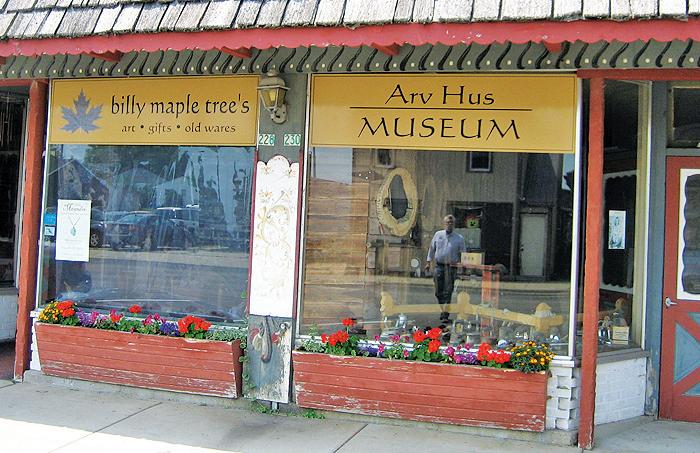
Ann laughs at the quirky antics of her father, who died a few years ago. He told many stories in that museum. He wanted kids to see what oldtime outhouses were like, so he built one in the museum. The walls hold one of his creations: a sawdust and glue mural for International Harvester’s centennial. It boasts 10 different colors of sawdust, four gallons of glue, and 250 hours to complete.
Ann is keeping the heritage of those buildings alive, and is on her way to following her father’s storytelling footsteps as she relates the stories behind the artifacts. It’s a small town gem.
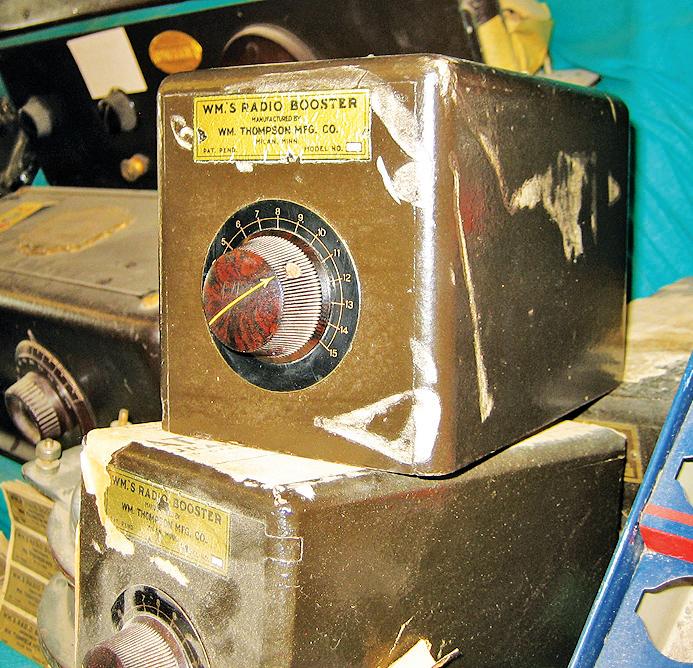
You can find Billy Maple Tree’s on Facebook. It is open Thursday, Friday, and Saturday from 10 a.m. to 4 p.m. The museum is open then or by appointment. Call Ann at (320) 734-4868. v

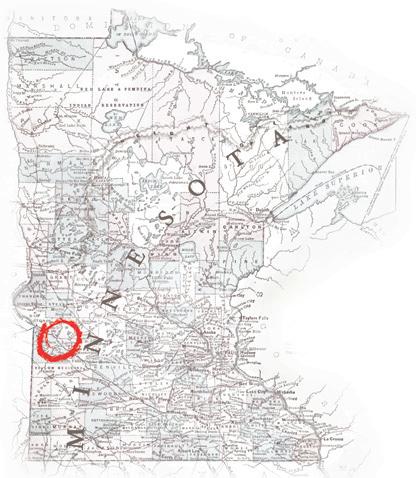
PAGE 24 www.thelandonline.com — “Where Farm and Family Meet” THE LAND — APRIL 12, 2024
Minn.
Milan,



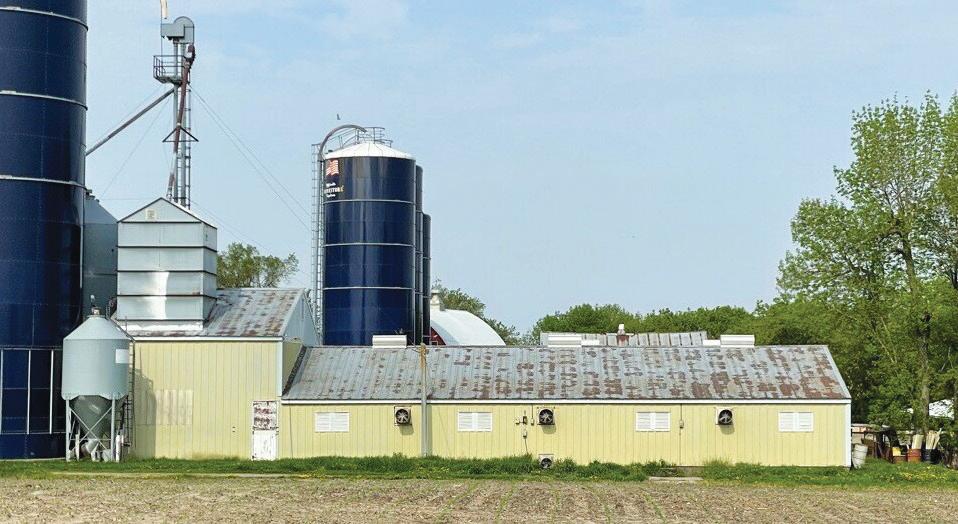
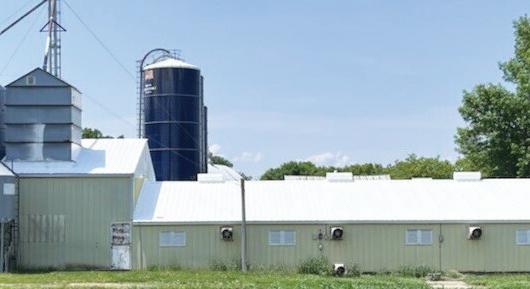
greenerworldsolutions MN LIC BC639351 855-612-8038 www.greenerworldsolutions.com CALL TO SCHEDULE AFREE ESTIMATE AMinnesota Family-Owned Business Eliminate Leaks Tighten Fasteners Prevent Rust DON’T GO ANOTHER YEARWITHALEAKING METAL ROOF Your FamilyLocalOwned Business Mankato, MN 56001 ©2023 Before After (800) 657-4665 www.TheLandOnline.com theland@TheLandOnline.com 418 South Second St., Mankato, MN 56001 © 2024 April 12, 2024
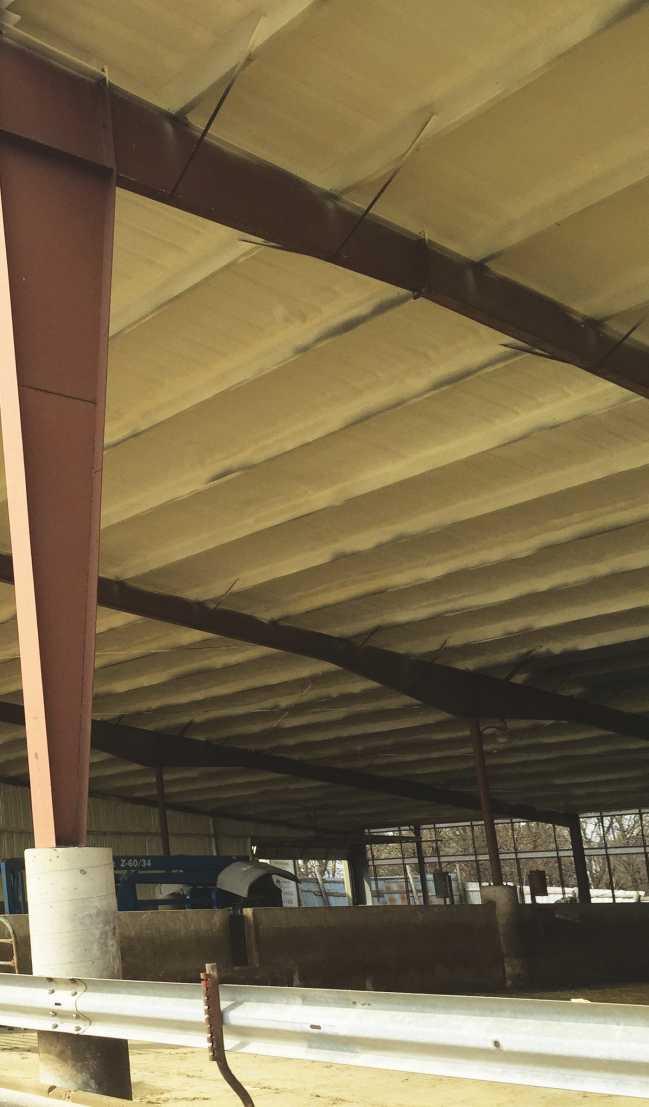

CALL TODAY TO SCHEDULE A NO-OBLIGATION CONSULTATION. 855-612-8038 www.greenerworldsolutions.com Serving Minnesota, South Dakota, North Dakota, Wisconsin and Iowa. MN LIC BC639351 Spray foam insulation prevents condensation in barns. Call today for a free quote. 855-612-8038 Page 2 - April 30/May 7, 2021 THE LAND, Advertising Supplement Page 2 - September 2023 THE LAND, Advertising Supplement CALL TODAY TO SCHEDULE A NO-OBLIGATION CONSULTATION. 855-612-8038 www.greenerworldsolutions.com Serving Minnesota, South Dakota, North Dakota, Wisconsin and Iowa. MN LIC BC639351 Spray foam insulation prevents condensation in barns. Call today for a free quote. 855-612-8038 Page 2 - April 30/May 7, 2021 THE LAND, Advertising Supplement April 12, 2024


April 30/May 7, 2021 - Page 3 THE LAND, Advertising Supplement CALL TODAY TO SCHEDULE A NO-OBLIGATION CONSULTATION. 855-612-8038 www.greenerworldsolutions.com Serving Minnesota, South Dakota, North Dakota, Wisconsin and Iowa. MN LIC BC639351 September 2023 - Page 3 THE LAND, Advertising Supplement April 30/May 7, 2021 - Page THE LAND, Advertising Supplement CALL TODAY TO SCHEDULE A NO-OBLIGATION CONSULTATION. 855-612-8038 www.greenerworldsolutions.com Serving Minnesota, South Dakota, North Dakota, Wisconsin and Iowa. MN LIC BC639351 April 12,

SPRAY FOAM INSULATION SHOPS BARNS SHEDS HOMES



VISIT US AT THE FARM & POWER SHOW
Page 4 - April 12, 2024 THE LAND, Advertising Supplement
















































































































